The post First Nations Queer Campaign and Activist Poster Art – A Reclamation Steven Lindsay Ross appeared first on IndigenousX.
This post was originally published on IndigenousX.
The post First Nations Queer Campaign and Activist Poster Art – A Reclamation Steven Lindsay Ross appeared first on IndigenousX.
This post was originally published on IndigenousX.
About 100 coffee growers in Vietnam’s Central Highlands staged a protest to regain land rights they lost after they stopped sending some of their crops to a forestry company that had allotted the parcels to them but did not invest in production, farmers involved in the demonstration said Thursday.
The Southeast Asian country is one of the world’s leading exporters of coffee, with the Vietnam General Statistics Office predicting exports worth U.S. $3 billion for 2021, up more than 9.4% over the previous year. The Central Highlands are Vietnam’s largest coffee-growing area,
The protest followed a court ruling against farmers who refused to provide Buon Ja Wam Forestry Company Ltd. with a portion of their annual output as rent payment.
The group of farmers from the country’s majority Kinh ethnic group and ethnic minority people who live in Ea Kiet village of Cu M’Gar district have gathered for four days to object to the revocation of land-use rights, they said.
The farmers say they cleared the land themselves, but then had to turn over what they produced to the company, which collected their crops without providing fertilizer, water or technical assistance.
The Cu M’Gar District People’s Court issued the ruling in a lawsuit initiated by Buon Ja Wam against the farmers.
In 2018, the company took legal action against 13 households that had failed to fulfill their responsibilities in accordance with leasing contracts they signed with the company.
In 1993, local authorities allocated 6,940 hectares (17,149 acres) of forest land in the Eo Kiet and Ea Kueh commnunes to Buon Ja Wam. Three years later, the company signed contracts with local residents stating that it would lease them 400 hectares (988) of land and receive part of their crops as rent payment each year.
But since 2016, many farmers have refused to deliver their crops to the company, which then sued them for nonpayment of debt and demanded they return the land.
A resident of one hamlet in the area, who requested anonymity for safety reasons, said the farmers decided to fight for their rights in response to the company’s dishonesty.
“As we all know, when doing business together, the company should have had some investments to enable farmers to do their farming work so that they could pay taxes and products to the company,” he said.
“Although the company did not give farmers a single grain of fertilizer or a drop of water or any technical assistance, it still collected the farmers’ crops,” he said.
The villager also said that Buon Ja Wam used to send staff to intimidate and threaten farmers who failed to make their in-kind payments on time, beating some to the point where they sustained serious injuries.
Local authorities told the villagers that they could not do anything to help them.
“We think there must be an interest group backing this company,” the resident said. “Their wrongdoings have been obvious, but as rank-and-file farmers, we had no choice but to work as slaves.”
RFA was unable to reach Buon Ja Wam for comment.
Dialogue unlikely
In an article published by Vietnam’s Business and Integration online newspaper in 2018, Phan Quoc Tan, Buon Ja Wam’s deputy director general, said the reason why farmers had stopped making in-kind payments was that “bad guys had encouraged and incited them to do so.”
Local farmers wanted to meet with company officials to discuss the situation, but the company refused the request, said another farmer who also requested anonymity for the same reason.
“Although local residents requested in earnest that Buon Ja Wam Company, local authorities at all levels, and coffee growers sit down together, they [the company] refused to do so,” he said.
“We want the local authorities to mediate the dialogue so that we can find a solution that is mutually beneficial and minimizes losses for both sides,” he said. “We have requested such a dialogue many times, but the authorities still have failed to make it happen.”
Residents say that they cleared the land in the 1980s when the government called for the development of new economic zones in the Central Highlands, and that officials did not allocate the land to Buon Ja Wam to grow coffee until 1996.
Because of this, local residents argued that the government should have granted land-use rights to them instead of to the company.
A farmer who lives in another hamlet in Eo Kiet said his family never received a land-use certificate for a parcel of land they bought from a family who had cleared it in the 1980s.
Although his family has been living on the land for years, they fear they will lose it due to their lack of the certificate.
“What we want is for the authorities, especially the Dak Lak People’s Committee, to revoke the land from the company and return it to the local government,” he told RFA. “Then the local government could allocate the land to local residents so that we can grow crops on our own land in order to pay taxes to the state and secure our livelihoods.”
RFA could not reach Cu M’Ga district officials for comment.
Reported by RFA’s Vietnamese Service. Translated by Anna Vu. Written in English by Roseanne Gerin.
This content originally appeared on Radio Free Asia and was authored by Radio Free Asia.
This post was originally published on Radio Free.
The Trades Union Congress (TUC) was supposed to be protesting at this year’s Tory spring conference, but it ended up redirecting its energy to the Russian invasion of Ukraine. Never fear, though – as local groups in the North West are refusing to let the Tories off the hook that easily.
The conference is taking place on 18 and 19 March at the Blackpool Winter Gardens.
On 9 March, the TUC said it was cancelling its planned protest on Saturday 19 March. It said in a statement:
Over the coming fortnight we will be mobilising trade unionists in support of the ITUC day of solidarity with Ukraine on 15 March.
And we will support the mobilisations in London and around the UK for the UN Antiracism Day on 19-20 March – particularly as this government refuses to welcome enough refugees from Ukraine into the UK.
The wages and bills crisis is about to bite. The TUC and the whole trade union movement demand action. So we will be bringing our campaign to win pay rises and a new deal for workers to a town or city near you soon and hosting a national mobilisation in London this summer. Dates and details to be announced soon.
But local groups clearly felt they should still take action.
So, two days of action are happening anyway. Wendy Fell from Blackpool, Fylde and Wyre Trade Union Council and Unite Community Lancashire said in a statement:
Within 24 hours we and allies locally… turned round the TUC pulling out. We have got things agreed with the police who will be all over that area of Blackpool. We have got a march route organised and adverts and social media material ready.
The two days of action will see plenty going on. On 18 March, St Johns Square in Blackpool will see stalls and speakers from 1pm. Then, on 19 March, people will meet at the Comedy Carpet on the sea front near to the Blackpool Tower. They’ll march to the Tory conference at Winter Gardens/St Johns Square. If you can make it in person, be sure to follow the demo on social media:

Fell said that the Tories:
will try and dominate the domestic news agenda with their narrative. While the media and the Conservatives are in Blackpool, we will attempt to get our own ideas across, ideas which include social justice and fairness – unlike theirs.
The Conservatives haven’t had a conference here since 2007 and it warrants a big turnout to let them know we’re watching. Watching as they trash our NHS, increase food-bank use, give their mates lucrative contracts, fail to deliver on any promises, ignore the refugee crisis, refuse to act on the environment, the cost of living crisis and so much more.
With the price rises and cost of living crisis, disabled people face the devastating impacts of poverty more fiercely than other demographic. Please do all you can to help us in that crucial task.
So, if you’re in or near Blackpool on 18 and 19 March, it’s time to show the Tories that people won’t take their toxic governance lying down.
Featured image via Sky News – YouTube
By Steve Topple
This post was originally published on The Canary.
This content originally appeared on Radio Free Europe/Radio Liberty and was authored by Radio Free Europe/Radio Liberty.
This post was originally published on Radio Free.
Asia Pacific Report newsdesk
Indonesian police have arrested a total of 90 Papuan students during a protest action near the Presidential Palace complex in Central Jakarta which ended in chaos with allegations of assaults on six protesters.
The demonstration by the Papuan students last Friday was to oppose the creation of new provinces in Papua.
“A total of 90 people”, said Metro Jaya regional police public relations division head Senior Commissioner E Zulpan when sought for confirmation on the arrests.
After being arrested, the students were taken to the Metro Jaya regional police headquarters.
Zulpan said that they would be returned home after being questioned.
“They will be returned home after being identified and questioned,” said Zulpan.
The protest, which ended in chaos, resulted in Central Jakarta district police intelligence unit head Assistant Superintendent Ferikson Tampubolon suffering head injuries after being allegedly assaulted by the protesters.
In addition to this, a number of other police officers were injured.
The demonstrators claimed that five protesters suffered injuries during the clash with police. One of them, a women, was knocked unconscious.
Zulpan however denied that police assaulted any of the demonstrators.
“There were no police officers who assaulted the demonstrators,” said Zulpan.
Advocacy Team slams police violence
The Papua Advocacy Team has called on the Metro Jaya police chief to punish the police officers who allegedly committed violence against six Papuans during the rally near the Presidential Palace.
One of the Advocacy Team members, Teo Reffelsen, said that if the acts of violence by police were based on an order from a superior officer, then they must also be held responsible.
“Police must legally process police officers who committed the violence against the six Papuans,” said Reffelsen in a written release sent to CNN Indonesia.
“If it was based on an order, then their senior officer must also be held criminally responsible,” he said.
Reffelsen also said that based on information obtained from the participants in the action, one of the six students, Ince, was kicked in the chest by a police officer and fell unconscious.
Another, Bob, suffered scratches to his leg and chest after being kicked. Samuel Purwaro was kicked and dragged into a detention vehicle and suffered injuries to his right eye, and Deris Murib was kicked in the forehead and back of his body.
Daten meanwhile was struck in the head using a motorcycle helmet and a member of Solidarity Indonesia was kicked by police.
Suffered injuries, cracked teeth
“He suffered injuries to his body and cracked teeth. His genitals were grabbed, then his mobile phone. [But] his mobile phone has been returned,” said Reffelsen.
The Papuan students clashed with police near the Presidential Palace when they wanted to move off to the Home Affairs Ministry to protest against the creation of six new provinces in Papua.
Around 30 people claiming to be Papuan students tried to head off to the nearby Home Affairs Ministry on Jalan Medan Merdeka Utara via Jalan Veteran near the State Secretariat building in the presidential complex.
There, scores of police officers had already prepared a blockade and the demonstrators were prohibited from going any further. Tough negotiations between the two parties proceeded for up to 30 minutes.
The police continued to refuse to let the demonstrators pass and the two sides began pushing and shoving each other. A short time later the demonstrators broke through the blockade.
Police then chased the students and succeeded in breaking up the demonstration. Several were involved in fist fights.
IndoLeft News notes: A second article by CNN Indonesia later on the same day reported that 89 of those arrested had been returned home. “Yes, they’ve been sent home”, said Zulpan when sought for confirmation. Zulpan said however that one person named Alfius Wenda was still being questioned in relation to the alleged assault on Assistant Superintendent Ferikson Tampubolon.
Translated by James Balowski for IndoLeft News. The original title of the article was Demo Papua Berujung Ricuh di Dekat Istana, Total 90 Orang Ditangkap.
This post was originally published on Asia Pacific Report.

Tens of thousands of people took to the streets to join anti-war demonstrations across Europe on Sunday as Russia continued its deadly assault on Ukraine, bombarding major cities and intensifying a humanitarian crisis that is having reverberating effects worldwide.
In addition to protests in Berlin, London, Warsaw, and Madrid — where participants carried signs and banners that read “Stop the War” and “Peace and Solidarity for the People in Ukraine” — demonstrations sprang up on a smaller scale in occupied Ukrainian cities and in Moscow, despite the threat of arrest and police brutality.
Thousands of Russian anti-war protesters have been detained and abused by law enforcement since the invasion of Ukraine began on February 24, according to human rights organizations.
Despite threat of arrest, kidnapping and worse, Ukrainians in their thousands still come out to protest against occupying Russian forces. This latest video from Berdyansk on the Azov coast. pic.twitter.com/AFUf2bz0Wa
— Oliver Carroll (@olliecarroll) March 13, 2022
The demonstrations Sunday came amid some signs of diplomatic progress in talks between Russia and Ukraine, which have been negotiating on the border of Belarus since the early days of the invasion.
Mykhailo Podolyak, an adviser to Ukrainian President Volodymyr Zelenskyy, said Sunday that Russia is “beginning to talk constructively” and predicted that “we will achieve some results literally in a matter of days.”
Leonid Slutsky, a Russian delegate to the negotiations with Ukraine, echoed his counterpart’s assessment.
“According to my personal expectations, this progress may grow in the coming days into a joint position of both delegations, into documents for signing,” Slutsky told reporters Sunday, without offering specifics on what an agreement would entail.
Seemingly positive developments in diplomatic talks came as Russia showed no sign of easing its attack, which has forced more than 2.5 million people to flee Ukraine and internally displaced millions more.
Zelenskyy said Saturday that around 125,000 people have been able to escape through humanitarian corridors established in besieged cities, but hundreds of thousands remain trapped in Mariupol and other areas facing heavy shelling from Russian forces.
Early Sunday morning, Russia bombed a Ukrainian military facility located just 22 miles from the border of Poland, a NATO member. The airstrike, believed to be Russia’s westernmost attack on Ukraine thus far, killed dozens of people and wounded more than 130 others.
The Associated Press reported that “continued fighting on multiple fronts heaped further misery on the country Sunday and provoked renewed international outrage.”
Brent Renaud, an American journalist who had previously contributed to the New York Times, was killed by Russian forces in the town of Irpin, Ukrainian authorities said Sunday. A second journalist who was traveling with Renaud was reportedly injured.
“We are shocked and saddened to learn of the death of U.S. journalist Brent Renaud in Ukraine,” Carlos Martinez de la Serna of the Committee to Protect Journalists said in a statement. “This kind of attack is totally unacceptable, and is a violation of international law. Russian forces in Ukraine must stop all violence against journalists and other civilians at once, and whoever killed Renaud should be held to account.”
According to the United Nations, at least 549 civilians have been killed and nearly 1,000 have been wounded since Russia invaded Ukraine — estimates that are believed to be significant undercounts.
Local Ukrainian officials said Sunday that 2,187 civilians have been killed in Mariupol alone since the start of Russia’s attack.
This post was originally published on Latest – Truthout.
A New Zealand protest flotilla has arrived outside the luxury Northland home of Russian oligarch Alexander Abramov.
The eight vessels sailed to Helena Bay, north of Whangārei, early today to protest over the two-week-old Russian invasion of Ukraine facing the private estate owned by Abramov.
Locals on kayaks and boats were expected to join them.
The flotilla is asking the government to freeze Abramov’s New Zealand assets.
Although he is one of the few super-rich influential Russians with assets in New Zealand — a handful of wealthy Russians are estimated to have $60 million invested in the country — he is not on the official sanctions list intended to put pressure on Russia to stop the invasion of Ukraine.
The government has said the list will remain under review.
Greenpeace joins protest
The global environmental campaigner Greenpeace has joined the flotilla.
Greenpeace programme director Niamh O’Flynn is on board a yacht, and told RNZ the water was a bit choppy, but demonstrators plan to remain on their vessels in the bay and stay for a few hours to get their message across.
“The main message is that we need to do our bit to end this war peacefully, and that means sanctioning oligarchs, it means freezing the assets of oligarchs like Alexander Abramov, immediately.”
She said sanctioning oligarchs puts pressure on Russian President Vladimir Putin to end the war.
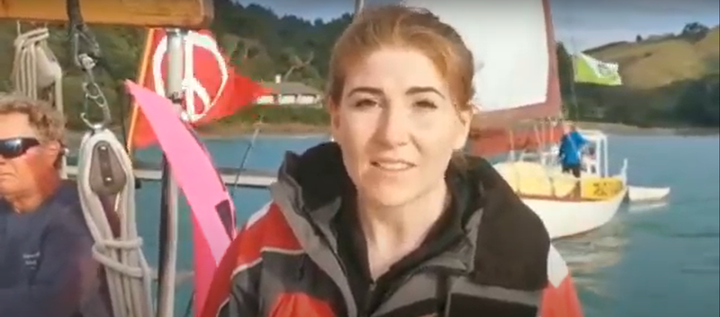
On February 24, the government announced a list of officials from the Russian government and others involved in the invasion of Ukraine, who are named in a targeted travel ban.
On March 9, the new Russia Sanctions Bill was passed by Parliament under urgency by all parties. It allows for New Zealand to impose harsher sanctions.
Some Northlanders living near Abramov’s lodge earlier put up Ukrainian flags on their properties.
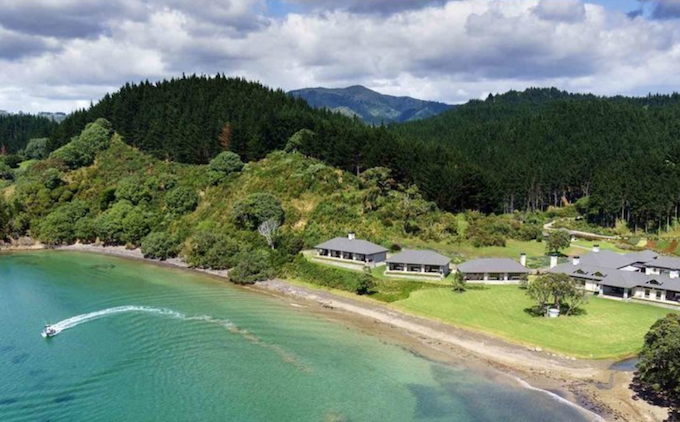
A roundup of the coverage of the struggle for human rights and freedoms, from International Women’s Day in Istanbul to ‘kill the bill’ protests in Cambridge
Continue reading…This post was originally published on Human rights | The Guardian.
Reclaim These Streets welcomes judges’ decision as ‘a victory for women’ and calls for Met reform
The Metropolitan police breached the rights of the organisers of a planned vigil for Sarah Everard in the way they handled the planned event, high court judges have ruled, in a decision hailed as a “victory for women”.
Reclaim These Streets (RTS) proposed a socially distanced vigil for the 33-year-old, who was murdered by a serving Met officer, Wayne Couzens, near to where she went missing in Clapham, south London, in March last year.
Continue reading…This post was originally published on Human rights | The Guardian.
Several hundred protesters marched down Oxford Street in Sydney on March 5 to celebrate the LGBTI community and to protest the Religious Discrimination Bill and the corporatisation of Mardi Gras.
The rally began at Taylor Square and ended with a dance party at Hyde Park. Organised by Pride in Protest (PIP) and Community Action for Rainbow Rights, the protest was attended by various community organisations, activists and the 78ers, organisers of the original 1978 Mardi Gras protest.
This post was originally published on Green Left.
Several hundred protesters marched down Oxford Street in Sydney on March 5 to celebrate the LGBTI community and to protest the Religious Discrimination Bill and the corporatisation of Mardi Gras.
The rally began at Taylor Square and ended with a dance party at Hyde Park. Organised by Pride in Protest (PIP) and Community Action for Rainbow Rights, the protest was attended by various community organisations, activists and the 78ers, organisers of the original 1978 Mardi Gras protest.
This post was originally published on Green Left.
On 3 March, private bailiffs evicted students who were peacefully occupying a university building at London’s School of African and Oriental Studies (SOAS). The occupiers characterise their eviction as ‘forceful and illegal’.
The eviction came nine days into the occupation, in which students made calls for a demarketised, decolonised education system. What they mean by this, is an education system that puts the needs of staff, students, and communities before profit. And one that challenges – rather than reproduces – systems of racist, colonial oppression.
On 23 February, SOAS Strike Solidarity – a group of students – began occupying senior management’s offices in the university’s main building. The occupiers delivered a set of demands for SOAS management to implement.
The students are fighting for a demarketised, decolonised education, free from institutional racism. This begins with the removal of SOAS director Adam Habib.
On 11 March 2021, Habib used the n-word during a meeting with students. The uni boss went on to justify his use of the racial epithet in a series of tweets. Reflecting his regressive impact on the university, SOAS terminated its undergraduate African Studies programme under Habib’s leadership. Protesting students deem actions such as this to be indicative of the institutional racism that continues to function within the university.
Habib is also connected to the violent suppression of student protests in South Africa. In his role as vice-chancellor of South Africa’s University of Witwatersrand, Johannesburg, he called in private armed security and police to suppress students calling for a free, accessible, and decolonised education as part of the Fees Must Fall movement.
In 2016, South African police used rubber bullets and tear gas to suppress protesting students on campus. Police shot protest leader Shaeera Kalla in the back nine times. And on 10 March 2021, police shot and killed student Mthokozisi Ntumba outside the police-occupied university campus. A number of the students involved in the Fees Must Fall movement remain political prisoners in South Africa.
In a statement, the SOAS Strike Solidarity group said:
The SOAS student body has no illusions that Habib’s appointment at SOAS was specifically linked to his experience in repressing student movements.
Habib’s appointment at SOAS is particularly disturbing given the university’s reputation as a progressive hub of critical anti-colonial thought and radical politics. It would appear that university bosses continue to exploit this image to attract students and academics while suppressing radical political action on campus.
The student group is also protesting in solidarity with university staff who are engaged in an ongoing fight against widespread race, gender, and disability pay gaps; increased casualisation and precarity; increasing workloads and real-terms pay and pension cuts. The students are urging university management to meet the University and College Union (UCU) and UNISON’s demands, and to cut senior management’s excessive salaries.
Protesting students are also urging management to improve working conditions for SOAS workers, particularly the university’s cleaning staff. And to meet the needs of disabled students.
SOAS Strike Solidarity has linked their fight for a demarketised, decolonised education with global struggles for social justice. They are demanding that the university divests from companies that are complicit in Israeli apartheid, and investigates its investments in companies that are complicit in human rights abuses against Uyghurs.
On 3 March, private bailiffs and security wearing riot gear evicted the SOAS occupiers “in the middle of the night”. SOAS Strike Solidarity claims that prior to the eviction, “management only engaged in one “official” session of negotiation with the occupiers”, and failed to acknowledge all of their demands.
Upon learning about the eviction, members of the student body gathered outside the building in resistance.
The Eviction Response Team carried out the eviction – a private company which shockingly boasts “a wealth of experience when it comes to the removal of protestors, squatters & travellers”.
SOAS Strike Solidarity maintains that three occupiers sustained injuries after private bailiffs “violently dragged” them out of the building. Their press release includes an image of one occupier’s grazed back.
In a statement, the group said:
This was an illegal eviction and at no point were occupiers violent, or causing criminal damage. SOAS Management did NOT have a court order to legally carry out this eviction, and thus resorted to a cowardly private eviction in the middle of the night.
Indeed, the eviction could be in breach of Article 10 and Article 11 of the Human Rights Act, as well as Section 6 of the 1977 Criminal Law Act.
However, a spokesperson for SOAS told The Canary:
After nine days of occupation we decided that allowing further disruption was untenable and we proceeded on the basis of common law. Throughout this period, we were closely advised by legal opinion on the matter and we strongly refute the allegation that the removal of the occupiers was illegal. The removal was conducted without any physical injury and our priority was to ensure the safety and security of all involved.
They added:
We had hoped to resolve this matter through dialogue and over the course of nine days, we engaged in extensive discussions with the occupiers on the progress already made on some of their demands and work underway on others. Despite these engagements, the occupiers consistently refused to leave the premises.
Reflecting on the institutional racism, imperialism, and marketisation which characterises the UK’s higher education system, SOAS Strike Solidarity said:
The occupiers, and the overall SOAS community, is outraged at the management for carrying out this eviction in such a violent manner. It has shown the true nature of the current management—unwilling to engage in any dialogue or negotiation with the demands of a significant proportion of the student body.
They added:
The force used in this eviction was just a brief exposure of the violence on which the institution is based. This includes the violence they inflict through the exploitation of immigrant workers and Global Majority students, and the history of colonial violence on which the institution is built. SOAS management is unwilling to respond to their students’ needs and instead are only interested in protecting their profit-making institution.
In spite of their traumatic experience, the group stands firm in their ongoing fight. SOAS staff and students are protesting on the university campus on Thursday 10 March.
STUDENT AND STAFF WALKOUT TMMR @ 12PM

Resist management’s authoritarian tactics. They have bolstered security, restricted the right to protest with dignity, and ILLEGALLY EVICTED students.
PUSH BACK AGAINST MANAGEMENT AND STAND WITH US ON THE SOAS STEPS
pic.twitter.com/YnwjokzQBI
— soasstrikesolidarity (@soasstrikesol) March 9, 2022
The SOAS Strike Solidarity group is urging supporters to join them in condemning their forceful eviction and demanding a free and fair education system for all.
Featured image with permission from SOAS Strike Solidarity
This post was originally published on The Canary.
Asia Pacific Report newsdesk
Scores of Papuan activists have held a protest in front of the Army Strategic Reserves Command (Green Berets) headquarters in Central Jakarta, demanding that President Joko “Jokowi” Widodo withdraw military troops from Papua, reports CNN Indonesia.
The protesters, who came from the Pro-Democracy Alliance and the Greater Jakarta Papua Student Alliance (IMAPA), accused the military in Papua of assaulting a primary school child for allegedly stealing a firearm and causing the child’s death.
“[We] demand that the president immediately withdraw the military from the land of Papua,” said one of the speakers in front of the Kostrad building on Monday.
“The primary school kid’s didn’t know it was a firearm. They didn’t know it was theft,” he said.
In an official release, the group also said that joint TNI (Indonesian military) and Polri (Indonesian police) operations following the fatal shooting of Papua regional National Intelligence Agency (BIN) chief Gusti Putu Danny in April last year have resulted in civilian casualties.
They said that the security forces have set fire to residents’ homes and committed violence against local people.
As a consequence, residents have chosen to flee their homes in order to save themselves.
“To the president, immediately withdraw the military in the land of Papua,” called the speaker. “Jokowi is responsible for the oppression in Papua.”
Earlier, on Sunday, February 20, a class 4 primary school student with the initials MT died after being allegedly assaulted by security personnel in the Sinak sub-district of Puncak regency, Papua.
Based on information received from Amnesty International Indonesia, the incident began when MT and six other children were arrested for allegedly stealing a firearm belonging to a TNI member in Sinak.
“Based on local media reports on February 26, two youths allegedly took a firearm belonging to a TNI member in the vicinity of the Tapulinik Sinak Airport, Puncak regency, Papua, on the evening of February 20,” read a tweet on the Twitter account @amnestyindo on Monday February 28.
[BREAKING] Kami juga kembali mendesak pemerintah untuk mempertimbangkan kembali pendekatan keamanan yang digunakan untuk merespon masalah di Papua.
Selengkapnya di https://t.co/79b0sRZdIy
— Amnesty International Indonesia (@amnestyindo) March 4, 2022
Translated by James Balowski for Indoleft News. The original title of the article was Aktivis Papua Demo di Depan Markas Kostrad, Desak Jokowi Tarik Militer.
This post was originally published on Asia Pacific Report.
On March 3, 2022, police in Pakistan’s capital, Islamabad, opened an investigation into Asad Ali Toor for allegedly leading an unauthorized protest earlier that week, according to news reports and Toor, who spoke to CPJ in a phone interview.
On March 4, the Islamabad High Court ordered police not to arrest anyone named in the case until another hearing on Monday, March 7; at that hearing, Chief Justice Athar Minallah said that police officers’ use of excessive force and the registration of a criminal case against the protesters constituted an abuse of state power, according to news reports.
Toor, who was present at the March 7 hearing, said that Attorney General Khalid Jawed Khan told the court that the state would withdraw the case. Toor told CPJ on March 9 that he had not been formally notified that the case had been withdrawn.
Khan and Shabbir Ahmad, the station house officer of Islamabad’s Kohsar police station who filed the complaint, did not respond to CPJ’s requests for comment sent via messaging app.
Toor told CPJ that he denied any leadership role in the protest, held on March 1 at the city’s National Press Club to protest the disappearance of an ethnic Baloch student, and only attended to cover it as a journalist.
A number of students were injured when police charged the protesters and attacked them with batons, according to Dawn. Toor alleged that the investigation was retaliation for his coverage of the protest and the police crackdown on his YouTube-based current affairs channel, Asad Toor Uncensored.
In a first information report, a police document opening an investigation, authorities accused Toor and several others of criminal conspiracy, rioting, unlawful assembly, obstruction of a public servant’s duties, defamation, and intentional insult with intent to provoke breach of peace. The most serious of those crimes, criminal conspiracy, can carry a death sentence, according to Pakistan’s penal code.
Previously, in September 2020, the cybercrime wing of the Federal Investigation Agency in the northern city of Rawalpindi filed a first information report against Toor for allegedly defaming the army through his social media posts, according to news reports.
After four months of legal proceedings, the Lahore High Court dismissed the case for lack of evidence, according to news reports and Toor. He said that the state never informed him or his lawyers about who filed the complaint that led to the registration of a first information report, or which social media posts were allegedly defamatory.
Separately, in May 2021, unidentified armed men attacked Toor at his home and left him bound and gagged, as CPJ documented at the time. Toor told CPJ that police have not identified the perpetrators of that attack.
CPJ emailed the Federal Investigation Agency and Islamabad Police Inspector-General Muhammad Ahsan Younas for comment, but did not immediately receive any replies.
This content originally appeared on Committee to Protect Journalists and was authored by Erik Crouch.
This post was originally published on Radio Free.
SPECIAL REPORT: By Rituraj Sapkota of Māori Television
“I have never had that fear before that I might get physically hurt,” says Patrice Allen, a Ngati Kahungunu and Newshub camera operator based in Wellington.
“You’re going down there, you don’t know what it’s going to be like. A person from Wellington Live got beaten up.”
Māori Television’s press gallery videographer David Graham (Taranaki Whānui and Waikato) started working as a news cameraman in Wellington in 1989. He was there for the seabed and foreshore protests, and “in the 1990s it was Moutua and Pakitore,” he recollects. “But this is the most volatile one I have seen.
“Back then we [the media] were part of the show. They wanted us to be there. Now we are a part of the ‘axis of evil’, along with the police and government.”
Up against your own
“Now there are Pākehā calling you kūpapa [Māori warriors who fought on the British colonial troops side during the New Zealand Wars in the 19th century],” he says. He has just returned from filming with his phone in the crowd, and has heard protesters say things. Nasty things.
“Stuff like ‘you should be ashamed of yourself. You should be ashamed of your whakapapa!’”
“I just don’t engage,” says Graham. “And I am not a random man with a camera here. I actually have whakapapa back to this marae on my father’s side,” he says, referring to Pipitea Marae where Taranaki Whānui laid down Te Kahu o Raukura as a cultural protection over the surrounding land that includes the Parliament grounds.
The protesters had lots of livestreams and many of them kept filming media camera-ops who were filming them. (Below: David Graham finds himself in one of the live feeds while a protester in the crowd heckles him.)
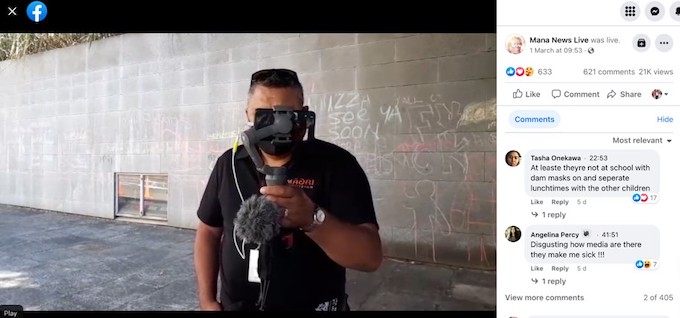
Allen feels the mamae is stronger when it comes from your own people.
“This happened on the day of the last protests,” she says, referring to the protests in November where the crowd threw tennis balls and water bottles at the media. She was filming a timelapse of the crowd leaving when a mother-son duo walked up to her.
“He was a big dude and he was really getting in my face. I was not feeling very safe. And I thought, ‘how can I diffuse this?’” So she asked them where they were from.
“And they were like where are you from? What are you?”
“Oh, Ngati Kahungunu, just over the hill in Wairarapa,” she replied. The man said something targeting not just her but also her iwi. “And that just broke my spirit,” says Allen.
“It was one of the days I went home and cried.”
‘We’re the enemy now’
“We are the enemy now,” says Allen. “And there is nothing you can do or say that will change their minds.”
Her teammate Emma Tiller thinks the camera can be a beacon in the crowd. “As soon as you put it up, everyone knows who you are. And they hate you.”
And even though security cover has become standard practice for all news camera-ops filming in the crowd, there are times she feels vulnerable. “It’s hard to think back to protests when we were out there. We didn’t have security with us. It didn’t even cross our minds.
“But now who wants to risk the violence?” she says.
“They have thrown things at the police. If they can do that to them, what can they do to us?”
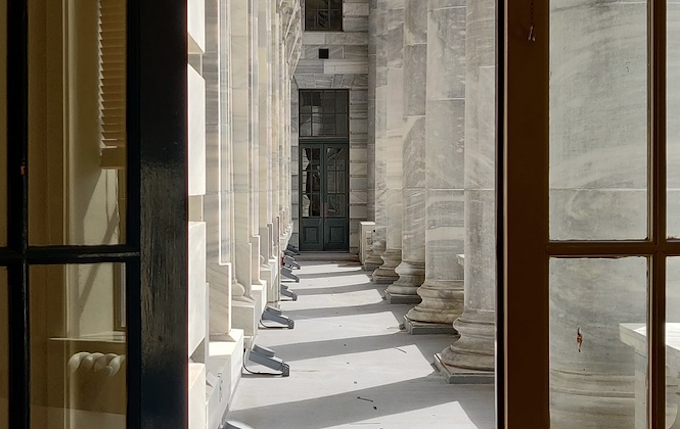

“The last time I had security was when I was filming in East Timor,” says Allen. It was a long time ago, she adds, and at a time and place when there were terrorists around.
“It’s really bad because it’s made it ‘us and them’, media against protesters, and it’s not supposed to be like that.”
‘Difficult to turn off’
Sam Anderson, 22, is TVNZ’s camera operator at the press gallery. “It has been difficult to turn off,” he says “ I have been there [on the Speaker’s balcony] from 9am to 6pm just streaming the whole day.
“It’s all you are doing – copping the abuse, being yelled at, having your morality questioned.
“I sometimes hide behind the pillars from the frontliners who can yell all day.
“And throw that in with reading all the signs around you,” says Tiller.
“And they yell at you. And you go home and you can’t switch it off.”
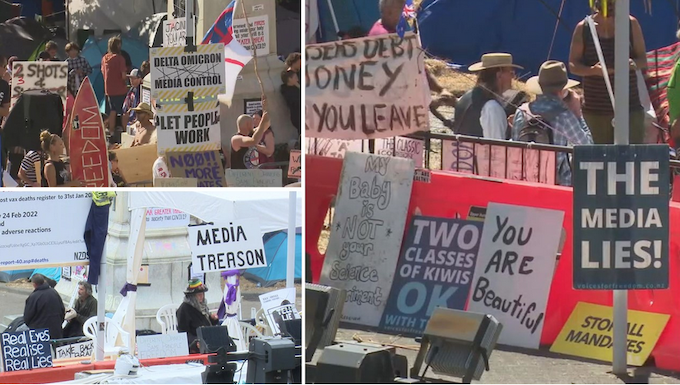
Anderson’s teammate, Sam von Keisenberg, was on that balcony on February 11 when police made many arrests. Shortly after they arrested someone at the forecourt and the crowd was yelling at the police, a lady pointed a finger at him and said “You! You are a paedophile protector!”
“At first I was like, ‘that’s new’. But then she said it 50 times, as loud as she could, just at me.”
He pulled his camera off the tripod. “It was getting to me”, he says. “I have children. I would never protect a paedophile.”
His colleague asked him where he was going. “Just to punch some lady in the face,” he said under his breath. “And I walked out and just went to the bathroom.”
Sweeping generalisations
“Sometimes you have to take a step back,” von Keisenberg says.
“I had never experienced hate [directed] at me before,” RNZ video journalist Angus Dreaver says. Especially this type, he says, where they think media are traitors, and they want them to know.
“Four months ago, I was doing kids’ TV.”
Dreaver thinks the generalisation works both ways. While the protesters see the mainstream media as a monolith and sweep them with one giant brush, “it’s important for us, conversely, not to see them that way.”
Von Keisenberg believes there were more moderates in the crowd than extremists. “I always felt there were enough people around me,” he says. And that made him feel safe in the first week when he was filming undercover, knowing that “if things did get violent, there would be some moderate ones who would stop them”.
He saw that in action, too. In his forays of the first week, when he joined the crowd unmasked to avoid attention. He saw a man there in his 70s wearing a mask.
“The first thing he said to me was that he was immunocompromised, which is why he was wearing the mask.”
“It’s fine, mate. It’s a freedom rally, do what you want,” von Keisenberg said. But another protester came up and “tried to pull his mask off and started berating him, saying he had no identity. The mob mentality started and people around the gate joined in and started giving him grief.”
Von Keisenberg intervened. “Oi! chill out man. It’s a freedom rally, he’s free to wear a mask!”
“A woman close by turned around and said, ‘Yeah, come on guys! leave him alone.’ And they did.”
Mainstream media
When people tell von Keisenberg that they don’t watch mainstream media, his follow-up is, “Well then, how do you know we are ‘lying’?”
“They say, ‘we get our news from Facebook, which is different’. Yeah, different, because there aren’t many rules around it,” von Keisenberg says.
“Mainstream media is held more to account than social media,” Allen says. “But they think the opposite.”
Some of Dreaver’s acquaintances have shared his photos on Instagram, in posts that read “Mainstream media are liars”. “Bro, that’s me!”, he says.
Trying to remain objective in the face of constant harassment is a real challenge.
“I am almost hyper-aware of that, where I am trying to capture the mundane and relax as much as the heightened states,” he adds. “And I am trying to not let my anger affect the pictures I take or how I cover it.”
But for camera operators, the task ends once they take the picture. “We only aim for clear sound and sharp, steady pictures,” Graham says. “The rest of the stuff is for other people to decide what to do with.”
Anderson thinks there are differences in perspectives within newsrooms. People who have watched the protests from a distance or from their desks often take a kinder view of the protesters, he says.
“But me and the other camera ops, we copped a lot of abuse over three weeks. We just have a more bitter taste in our mouths for this crowd.”
The PM in ‘disguise’
There have been the fun moments, though, Anderson admits. There have been “raves” with young people dancing on the frontlines and he found himself almost filming to the beat. And there was a protester who thought he was the prime minister in disguise.

“Now that is one theory I know is not true,” says his teammate von Keisenberg. But how does he know for sure?
“Because I have seen both of them in the same room at the same time.”
And von Keisenberg has had his fun moments in the crowd, too. In one instance when he was filming undercover, a woman went on the stage and started talking into the mic about electric and magnetic fields (radiation) and how crystals could block them.
“Bullshit!” von Keisenberg turned around and shouted.
“We are here for the mandates,” he added, not snapping out of character, and for the benefit of those around him who were listening to the woman speak.
A potential for volence
“The vibe changed every few days, and that was because people kept coming and going,” von Keisenberg says. “But there were always the elements who were there for whatever happened on day 23.”
One camera op I spoke to said there had been a “potential for violence” right throughout. And when someone like Winston Peters visits the crowd and says “the mainstream media have been gaslighting you for a long time,” it gives them validation, and lends credibility to their theories.
But for those on the ground gathering news amid a hostile crowd, it exacerbates the possibility for harm.
Added to this potential of violence is the constant anticipation of things to come. “You have to be always prepared for when something will happen,” as Tiller puts it. “And that is exhausting.”
Emma Tiller describes her experience of the Speaker’s balcony as, “You feel like you have to be prepared for if something is going to happen, and that is exhausting.”
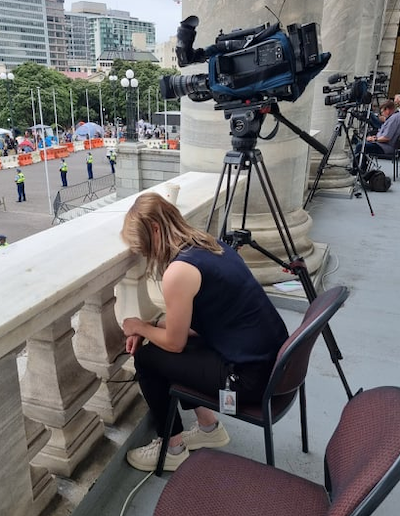
“The day things turn to custard, you want to be there on the ground,” Graham said to me a few days before the police operation. “You don’t want to be at home watching it on TV.”
And turn to custard it did; the threat of violence became reality on day 23. While the “battle” raged between the police and the protesters, the media people found themselves being targeted.
Dreaver was in the crowd by the tent where a fire had started. “A Mainstream! We have got a Mainstream here,” a woman who spotted him started shouting.
Brandishing a camping chair, she told him to, “get out of here! Out! Out!” The riot police were advancing behind him and he stood his ground.
“She started hitting me on the back with it,” he said. “She didn’t have a lot of speed but it was still a metal chair.”
“It hurt a bit,” he reckons.
“Get out of here,” demands the woman who attacked Dreaver with a chair. “Just go” shouts a man standing beside her. Screengrab from RNZ’s video story.

‘Not everyone’
“There were some protesters who were trying to stop the violence. Even right at the end,” says Dreaver, recollecting how when some people were breaking up bits from the concrete slabs to get smaller throw-able chunks, another person tried to physically get in the way and stop them.
“But the other guys had a metal tent pole and whacked him over the head with it.”
Throughout the three weeks of protests, there had been repeated calls from the protesters asking the media to talk to them. On the morning of day 23 when I was filming from the Speaker’s balcony, a TV reporter had just finished a live cross into the bulletin.
A man’s voice rang out from among the crowd, on the PA, inviting the media on the balcony to “come down and talk to real people and report the truth.” The same voice went on to berate us for wearing masks, behind which we were allegedly smiling smugly.
Less than a minute after the initial invitation, he followed up with another call to step down so he could put a fist through the mask.
“Why don’t you come down to talk to us? Because getting bashed with a chair was always inevitable,” says Dreaver. “It’s crazy it took so long.”
Protesters whacked another protester with a tent pole as he tried to stop the violence. “It didn’t look as though it injured him, because the tent poles are quite light, but it looked quite gnarly,” Dreaver says.
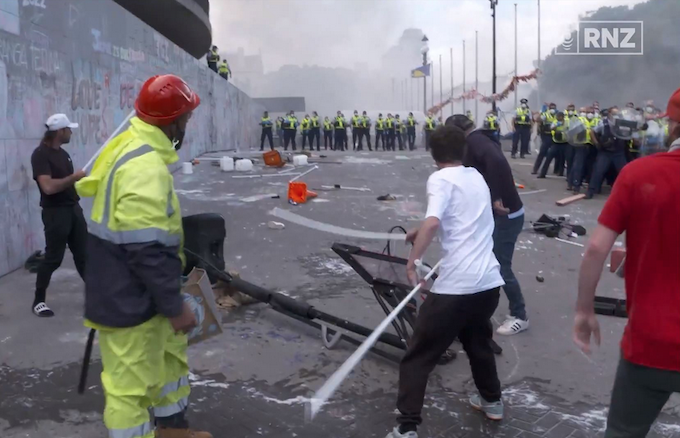
The aftermath
Parliament’s grounds have been reclaimed. All but one street around the buildings is now open to the public. On Sunday, Te Āti Awa held a karakia to reinstall the mauri of the land. There is currently a rāhui over the Parliament grounds.
It is time for healing. And moving on.
“I was feeling sad last week. And then I look at Ukraine and realise there are bombs going off next to all these journalists and camera operators,” Dreaver says “I got hit with a camping chair and I am going to sit around and complain about it?”
The effect of these protests linger though. Graham spent last Friday a week ago filming the hau kainga at Wainuiomata on high alert, and trying to keep the protesters from entering and setting up camp on their marae, as have other hapū around the capital.
The crowd has dispersed but not vanished, and neither has their kaupapa.
“I have seen some of their kōrero online,” Graham says. The mandates might be gone soon, but “there will be other stuff,” he reckons.
“It’s definitely not over.”
Rituraj Sapkota is Māori Television’s videographer in Parliament’s press gallery. Republished with permission from Te Ao Māori News.
This post was originally published on Asia Pacific Report.

On Monday, hundreds of students staged a walkout at a high school in Orange County, Florida, demonstrating against a proposed bill that would limit discussion of LGBTQ issues in schools throughout the state.
More than 500 students participated in a protest at Winter Park High School, organized to oppose legislation — colloquially known as the “Don’t Say Gay” bill — that is currently being debated in the state Senate. The legislation would ban discussion of LGBTQ issues in primary school classrooms and severely curtail what can be discussed in older grades, and could have disastrous repercussions beyond lesson plans.
Gov. Ron DeSantis (R) has signaled that he will sign the bill into law if it reaches his desk.
Students at Winter Park High School shouted slogans in support of their LGBTQ peers, chanting “We say Gay” to demonstrate their opposition to the bill. Students taking part in the demonstration also held signs in support of transgender students.
Students at my alma mater, Winter Park High School, protesting the “Don’t Say Gay” bill.
I’m so incredibly proud
pic.twitter.com/lJxDRS8eZj
— Jack Cocchiarella (@JDCocchiarella) March 7, 2022
Will Larkins, a junior at the high school and one of the students who helped organize the protest, said that the walkouts would continue if the legislation moved forward or was eventually passed into law.
“We wanted to show our government that this isn’t going to stop,” Larkins said to CNN. “There were walkouts all last week. This is going to continue. If this passes, there will be protests everywhere.”
A student who took part in a separate walkout, which took place last week at Flagler Palm Coast High School in Palm Coast, Florida, says that he was suspended for handing out Pride flags to participants.
Jack Petocz, a junior who helped organize the walkout against the anti-LGBTQ bill, said that the principal of the school told him ahead of the event that he wasn’t allowed to hand out rainbow flags.
The school’s principal questioned “the intentions of our protest, asking if pride flags were relevant to opposition to the bill,” Petocz later explained. “I decided to move forward and handed the flags to other student organizers for distribution at the event.”
After the protest concluded, Petocz said that he was called into the principal’s office yet again, and suspended for being “disrespectful and openly advocating against staff.” The junior says that he plans to speak to his family’s lawyer about the events.
Experts predict that the “Don’t Say Gay” bill will have a detrimental effect on students if it is passed into law. “The likely outcome of the bill would be to deter teachers from addressing these issues and to chill open discussions and support for lesbian, gay, bisexual, and transgender students,” Ryan Thoreson, a researcher at Human Rights Campaign, said in February.
It’s also possible that the bill could result in increased harassment of LGBTQ students, and less consequences for those who bully them; due to the bill’s vague language, students might feel as though they are unable to discuss their situation with teachers, and may be less willing to share that their LGBTQ status is the basis for their harassment
This post was originally published on Latest – Truthout.
In Turkey, International Women’s Day is not celebrated only at corporate breakfasts and morning teas. It is celebrated on the streets and at night by marching, dancing, and chanting. At Feminist Night Marches, celebration also means resistance, writes Burcu Cevik-Compiegne.
This year marks 20 years of Feminist Night Marches in Turkey. On 8 March International Women’s Day, women take to the streets in major cities to march, sing, dance and repeat their iconic slogan: “If you ever feel hopeless, remember this crowd”.
“If you ever feel hopeless, remember this crowd”
This is a simple yet powerful slogan, as it is not uncommon to feel hopeless in this country. At a time when femicide and transphobic crimes have skyrocketed, it is easy to succumb to feeling powerless. In 2021, Turkey withdrew from the Council of Europe Convention on preventing and combatting violence against women and domestic violence.
The Istanbul Convention, as it is known, saves lives by laying out the framework to deliver justice and support to women who have suffered gendered violence. When a presidential decree can undo years of work overnight – which is essentially what happened when Turkey withdrew from the Convention – it automatically raises the question: what is there to celebrate on the International Women’s Day in Turkey?
Celebration takes on a different meaning in the context of contemporary Turkey. An increasingly authoritarian rule has systematically attacked women’s rights and freedoms in an attempt to shape society made up of families after its own image, featuring an unrestrained, vindictive and self-righteous male head of the household. The role that is defined for women in President R. T. Erdogan’s so-called New Turkey is one of the dutiful wife and mother.
Against this background, claiming the streets and the night to perform their spiteful joy is a powerful response to neoconservative familism that aims to confine women to home, and their social and public life to the daytime only.
Women take to streets at night on every 8 March to express a range of views and emotions. In the current political environment, the power of their actions cannot be overstated.
The two emotions that stand out are anger and hope. Yet it is joy that links these two together and sets the atmosphere of the Feminist Night Marches. When women are told not to laugh out loud in public by top government leaders and they are arrested for insulting the President by jumping to the rhythm, a joyful celebration at night on the streets gains a whole new meaning; it becomes resistance.
The Night Marches do not use joy to tone down anger or smoothen the rough edges of feminism in a bid to make it more palatable. Women use music, dance and humour to create an atmosphere where they feel united, strong and untamed in equal measure. The witty and dark sense of humour that comes through the placards is not to please the outsiders. One often used slogan suggests “We don’t want a dictator, we want a vibrator”. Another advocates for “three orgasms per week” rather than the three children recommended by President Erdogan. These slogans intend to shock the sensibilities of the mindset that ties women’s sexuality to reproductive and marital duties.
This resistance hasn’t gone unnoticed. The authorities’ response to Feminist Night Marches is loud and clear. Every year, the security forces put in place blockades to prevent women from marching, using intimidation and arrests as dissuasive measures. The very same women who ordinarily feel threatened on those same streets become perceived as a threat to an order that oppresses them.
However, the reason why the authorities perceive the marches as a threat is not just about their challenge to the patriarchal order. Their unambiguously egalitarian ethos and the intersectional solidarity they foster are diagonally opposite to what an authoritarian regime wants and needs. Feminist Night Marches are the embodiment of resistance to authoritarianism.
The legitimacy of authoritarian rule depends on the polarisation of society, and the creation of constant crises. In a highly polarised society, like Turkey where difference can be a matter of life or death, Feminist Night Marches do not just tolerate, but instead embrace and celebrate difference. Run by a coalition of diverse organisations, the press releases are broadcast in four of the most common native languages spoken in Turkey (Turkish, Kurdish, Arabic, and Armenian).
Women can be seen carrying their placards in their native language, joined by the rainbow-coloured flags of the vibrant LGBTQI+ communities. Women proudly proclaim their identities as Muslim feminists, socialists or sex workers. Along with the Pride marches, Feminist Night Marches is arguably the only regular event that has achieved and nurtured such solidarity. And that in itself is worth celebrating!
The post Celebration becoming resistance: feminist night marches in Turkey appeared first on BroadAgenda.
This post was originally published on BroadAgenda.

We speak to Russian activist and historian Ilya Budraitskis after over 5,000 antiwar protesters were detained on Sunday as part of a sweeping crackdown on Russian civil society and the media. Activists in Russia are relying on alternative outlets such as social media for information, as the Russian government continues to censor major news outlets. Writers and independent news outlets such as Novaya Gazeta have faced the threat of criminal investigations for spreading so-called disinformation, which includes using the words “invasion” and “war” to describe Russia’s military actions in Ukraine, says Budraitskis.
Please check back later for full transcript.
This post was originally published on Latest – Truthout.
A troupe of environmental activists descended on Rotterdam, Netherlands, last month for an evocative demonstration. Dressed as jellyfish, sea anemones, and “fisher folk,” protestors from the advocacy group Ocean Rebellion sang songs and projected messages onto the hull of a 750-foot-long drilling ship, urging policymakers to protect the seafloor from mining companies.
“The Deep Sea Says No,” some signs read, as others called seabed mining “100% Unnecessary.”
Deep-sea mining in international waters is currently illegal, and environmental organizations, scientists, and many governments want to keep it that way. They argue that the practice could irreversibly harm one of the planet’s remotest ecosystems, one of the few places on Earth that has largely escaped human disruption.
Now, their calls have become increasingly urgent, as international regulators are expected to begin issuing deep-sea mining permits by the summer of 2023. Activists are trying to enlist everyone from tech companies to United Nations delegates in an all-hands-on-deck push to stop mining companies from exploiting the seabed.
“The ocean is 70 percent of this planet,” said Clive Russell, an activist with Ocean Rebellion. “We need to stop people from abusing it.”
The case for deep-sea mining is simple: As the world transitions away from fossil fuels, increased demand for technologies like electric vehicle batteries and solar panels will require massive quantities of cobalt, manganese, nickel, and other clean-energy metals. Land-based metal reserves are few and far between, and they’re often located near communities that are harmed by mining activities. But there are billions of dollars’ worth of these metals at the bottom of the ocean — far from civilization — and no one is yet taking advantage of them.
Some also argue that, by powering clean-energy technologies and thereby accelerating a shift away from fossil fuels, deep-sea mining will protect the oceans from unabated climate change. Rising CO2 emissions have already caused devastating ocean acidification, deoxygenation, and the decline of marine species populations around the world. Gerard Barron, CEO of the Metals Company, a Canadian firm that is already preparing vessels to begin mining the ocean deep, has argued that deep-sea mineral deposits are “the easiest way to solve climate change.”
However, ocean experts vehemently disagree. The deep sea is one of the planet’s most obscure places, home to tens or even hundreds of thousands of plant and animal species that are still unknown to humans. Scientists argue it would be reckless to disrupt this environment. According to research from the Max Planck Institute for Marine Microbiology, more than half of marine species in the Clarion-Clipperton Zone — a mineral-rich fracture zone that extends 4,500 miles along the floor of the Pacific Ocean — are dependent on the deep-sea mineral deposits that mining companies have set their sights on. Removing these potato-shaped deposits, which are known as polymetallic nodules, “would trigger a cascade of negative effects on the ecosystem,” the researchers concluded. And recovery would be nearly impossible, given the fact that these nodules take millions of years to develop.

There are other worries, too. Deep-sea mining would kick up debris from the ocean floor, and scientists worry that clouds of sediment could clog marine species’ filtration systems and make it harder for them to see through the water. Sonic disruptions caused by mining could also reverberate far and wide, negatively impacting whales and other species that rely on sound waves to hunt for prey. Meanwhile, fishing industry representatives have highlighted the practice’s risks to commercial fish stocks.
“The threat to biodiversity is really quite concerning,” said Jeffrey Drazen, a professor of oceanography at the University of Hawaii, Manoa. Drazen also warned that seabed mining could potentially exacerbate climate change by disrupting carbon sequestration dynamics in the deep ocean.
In short, experts agree that too little is known about the dangers of seabed mining for it to proceed safely, while a growing number assert that its risks vastly outweigh its potential benefits. The world’s clean-energy needs can be met with land-based mining, they argue, or better yet through technological innovation and dramatically improved recycling infrastructure that could significantly reduce the need for most mining in the first place.
Helen Scales, a marine biologist who teaches at the University of Cambridge’s Institute of Continuing Education, also emphasized the need for far-reaching, creative changes in the way the world adapts to climate change — like the dramatic expansion of public transportation. “Looking to the deep sea and saying we’re going to use those metals to build a billion electric cars is assuming that that’s what we should be doing,” she said. “It’s a very simplistic argument to say the only route to reduce carbon emissions is by mining the deep ocean.”
The reason the debate about deep-sea mining is escalating now is because of a surprise move from Nauru, a tiny island nation in the southwestern Pacific Ocean. Last summer, Nauru sent a letter to the International Seabed Authority, or ISA — the organization charged by the United Nations to regulate mineral-related activities in the deep ocean — expressing its intent to begin mining the seafloor in international waters. This triggered an obscure “two-year rule,” forcing the ISA to begin issuing deep-sea mining permits by the summer of 2023. The ISA will attempt to finalize regulations for seafloor mining before that deadline, but this is not necessarily required by law; ISA regulators are expected to open up the seabed to mining companies next summer even in the absence of a mining code.

It’s unclear whether the Metals Company, the firm that is partnering with Nauru, will have the technological or financial capacity to begin mining so soon. Duncan Currie, an international environmental lawyer who has worked with the Deep Sea Conservation Coalition, said that disagreements between countries over profit-sharing for deep-sea metals could also delay the start of large-scale seabed mining. The U.N Convention on the Law of the Sea explicitly calls for the “equitable sharing of the financial benefits” among ISA member countries and the European Union, Currie explained, but countries are “miles apart” on what that sharing should look like. Still, the timeline imposed by the two-year rule has still frightened many scientists and environmental advocates, who fear a “race to the bottom” for seabed metals.
“It’s reckless,” said Farah Obaidullah, founder of the advocacy group Women4Oceans. “This is something we know ahead of time is going to cause irreversible damage to the deep seas,” and it could begin without rules or regulations in place.
The Metals Company did not respond to Grist’s request for comment for this story.
Environmental advocates’ ultimate goal is to convince international lawmakers to put in place a moratorium on deep-sea mining. In response to the ISA’s looming deadline, 622 marine science and policy experts have called for a pause on the practice. Eighty-one governments and government agencies in the International Union for Conservation of Nature similarly called for a ban last fall. Other organizations and prominent individuals — including nature broadcaster David Attenborough and oceanographer Sylvia Earle — have made similar, often impassioned, pleas that seabed mining be halted.
Because the ISA has mining industry ties, experts don’t expect the group to ban deep-sea mining. The only body with the power to supersede the ISA’s authority and implement a moratorium on deep-sea mining is the U.N. General Assembly — but advocates don’t expect that to happen anytime soon. It’s very possible that companies could begin drilling in the deep ocean before U.N. member countries have a chance to stop them.
Given the pressing timeline, many advocates have focused on strategies that could offer immediate, albeit limited, protections for the deep sea while simultaneously drumming up support for a moratorium.
One strategy is to get large, metal-hungry companies to publicly disavow seabed mining. Arlo Hemphill, a senior oceans campaigner for Greenpeace, said these disavowals could show mining interests that there is insufficient demand from large corporations to make seabed mining profitable. The tactic has gained some traction, with large tech and car companies like Google, BMW, and Samsung promising to keep deep-sea metals out of their products. Banks like Triodos have also promised to exclude deep-sea mining from their financing.

Another approach would be U.N. intervention to bar deep-sea mining in critical ocean areas like the Clarion-Clipperton Zone. This is what some advocates hope could happen at a U.N. conference on marine biodiversity in international waters that will take place in New York starting this week. The conference is focused on the high seas, but according to Hemphill, it’s possible that it could have implications for the deep ocean as well. If negotiators agree on a treaty creating sanctuary zones for marine species — whales, for example — it could place entire swathes of the ocean out of the reach of mining companies.
The catch, however, is that for this approach to be effective, sanctuary zones would have to extend all the way down the water column, from the surface to the ocean floor. This is a big hurdle; according to Obaidullah, much ocean policy fails to connect these two sections of the ocean, treating them as distinct realms.
“As somebody with common sense, I don’t see how that’s possible,” she said. “If you start mining the deep ocean, you’re going to have sediment plumes in the water column at all stages, at all depths.”
Another caveat: Even if the U.N. comes up with a powerful treaty at its March meeting in New York, Obaidullah noted that ratification and implementation could take years — much longer than the 16 months remaining before mining companies may begin breaking ground in the deep ocean. She envisioned a scenario in which the ISA is opening up vast tracts of the seabed to extraction, even as other bodies are still haggling over how to conserve the waters directly above.
Hemphill expressed hope that a growing spotlight on the Metals Company, the two-year rule, and the dangers of deep-sea mining will stop the practice in its tracks. He supports a moratorium, but stressed the need to pursue parallel objectives: working to reduce or dependency on clean energy metals, for instance, by boosting recycling, designing products to last longer, and investing in public transit systems as an alternative to electric cars.
Russell, the Ocean Rebellion activist, agreed, calling for a sea change in the way humans interact with the ocean. “We need to begin to question why these people think that it’s a good idea to go deep-sea mining in the first place,” he said. “We have to start changing our relationships to the planet, and a big part of that is the ocean.”
This story was originally published by Grist with the headline Deep-sea mining could begin next year. Here’s why ocean experts are calling for a moratorium. on Mar 7, 2022.
This post was originally published on Grist.
Image: @tibettruth/tibetan source/rfa
Mr Tsewang Norbu, a 25 year-old Tibetan musician, who self-immolated in protest against China’s brutal and illegal occupation of Tibet, has died from his injuries according to information emerging from Tibetan sources. His sacrifice was made February 25 in front of the Potala, former residence of Tibet’s Dalai Lama.
This post was originally published on TIBET, ACTIVISM AND INFORMATION.
Twenty-eight of the anti-public health protesters who occupied New Zealand’s Parliament grounds over the past month have now tested positive for covid-19.
In a statement, the Ministry of Health said 11 district health boards had reported covid-19 cases from the protest, including Wairarapa, Waitematā, Waikato, Taranaki, Southern, MidCentral, Tairawhiti, Hutt Valley, Counties Manukau, Capital and Coast, and Canterbury.
“These people are thought to be protesters, although they have not been interviewed as they would have been prior to the recent changes in case investigation,” the statement said.
“In phase 3 [of the Omicron response], cases are not routinely interviewed by health officials and are instead asked to fill out a contact tracing form.
“Only cases that are identified through their interaction with the health system can therefore be identified as having attended the protest.”
The ministry is urging all those who were at the 23-day occupation to get tested and vaccinated.
The ministry also reported 17,522 new cases of covid-19 in the community across New Zealand today with 696 people in hospital — 13 of them in ICU.
The average age of those in hospital was 57.
Meanwhile, Wellington City Council said most of the remaining protesters seemed to have left the capital over the weekend, except for a group at Mahanga Bay who were not on council land.
Work was well underway to remove rubbish, deep-clean, and repair damaged roads, street lights and sewer pipes, it said.
The Department of Conservation said there were no protesters left at its Catchpool Valley campsite in Remutaka Forest Park, which was now closed for cleaning.
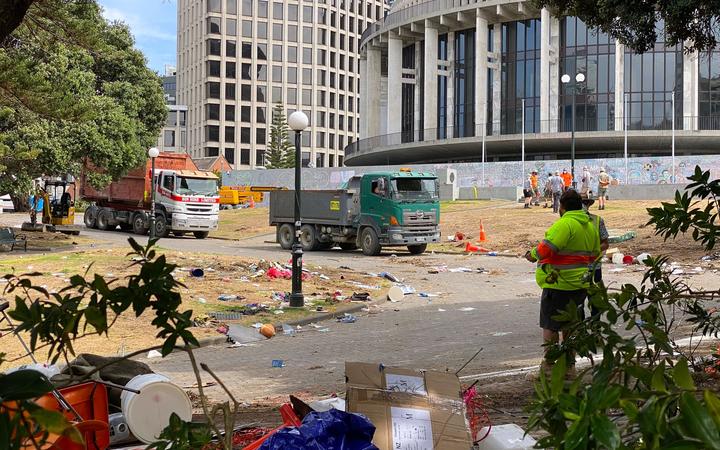
Christchurch library shuts for two hours over protesters
In the South Island, Christchurch central city library shut for almost two hours this morning when 40 protesters who were stopped from entering refused to leave.
A council spokesperson said Tūranga was closed after a warning that a group linked to the Freedom and Rights Coalition might protest there.
The council was not considering increasing security staff in response to the incident.
A police spokesperson said the 40-strong group was refused entry to the library because they did not have vaccine passes.
Police arrived at the library, where the group stood outside for a while before leaving, but no one was arrested or trespassed from the building.
This article is republished under a community partnership agreement with RNZ.
This post was originally published on Asia Pacific Report.
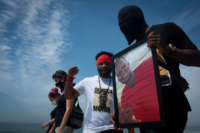
On February 5, protesters took to the streets of major Brazilian cities asking for justice. A young African man, Moïse Kabagambe, was lynched — tortured to death — on a beach in Rio de Janeiro in January. The alleged perpetrators, working men themselves, are in custody, and claim there was no intention to kill; that they were responding to the erratic behavior of the victim. The victim’s family, on the other hand, claims he was only asking to be remunerated for two days of work. No narrative, however, justifies what happened, which was caught on video.
To protesters, Kabagambe’s case went beyond the debate in court of whether his death was a homicide or an accident. The men involved claim their intention was to punish the immigrant for causing trouble, but the video shows how the beating went on for several minutes after Kabagambe was unresponsive, and the sheer physical stamina needed for the act implies hate was the fuel.
At the protest in São Paulo, African immigrants spoke of the disappointment they felt towards their reception in Brazil. Of how Brazilians need to do better to welcome African brothers and sisters, and to treat them as they would their family and neighbors. From the Congolese community, there was rage, pain and frustration; speakers’ voices cracked and pitched with angst. They came here looking for a better life, hoping to be embraced, and faced hostility and marginalization instead. Kabagambe’s case represents the rampant xenophobia Brazilians direct at Africans, remnant colonialism in labor relations and society at large, and the farce of racial democracy and meritocracy so often championed by Brazilian politicians.
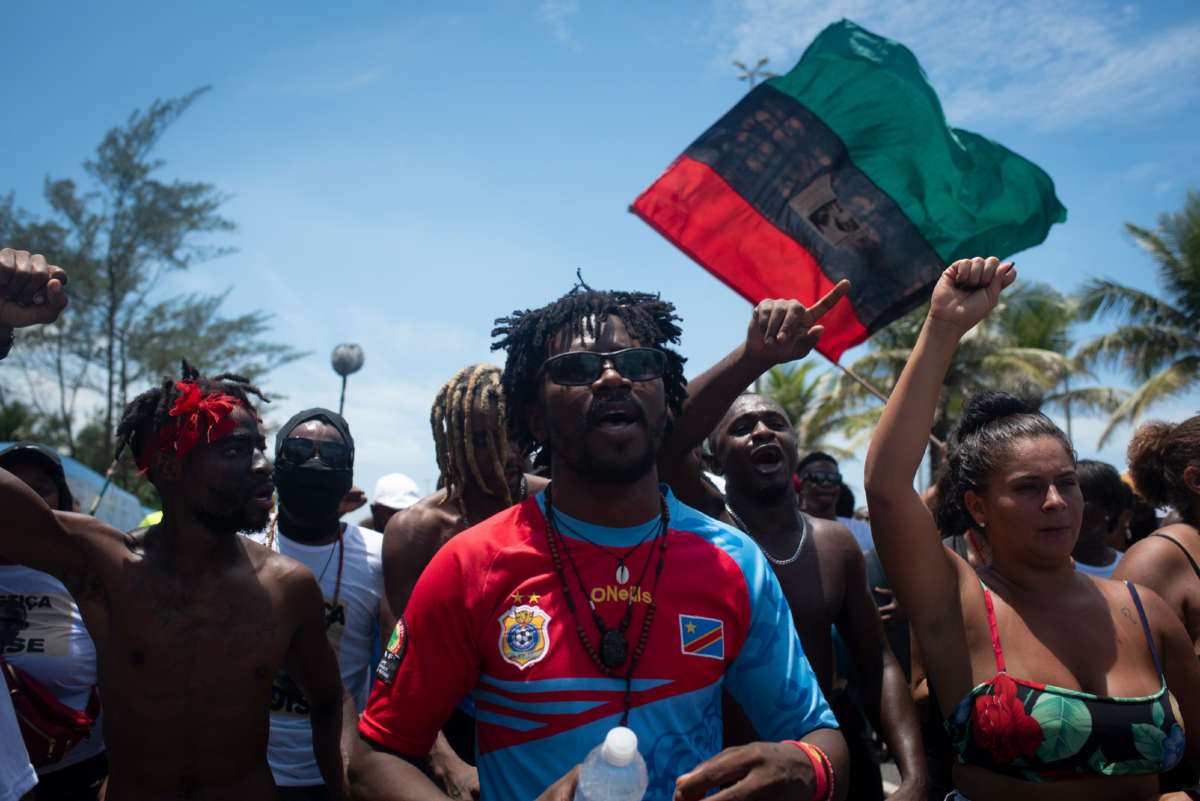
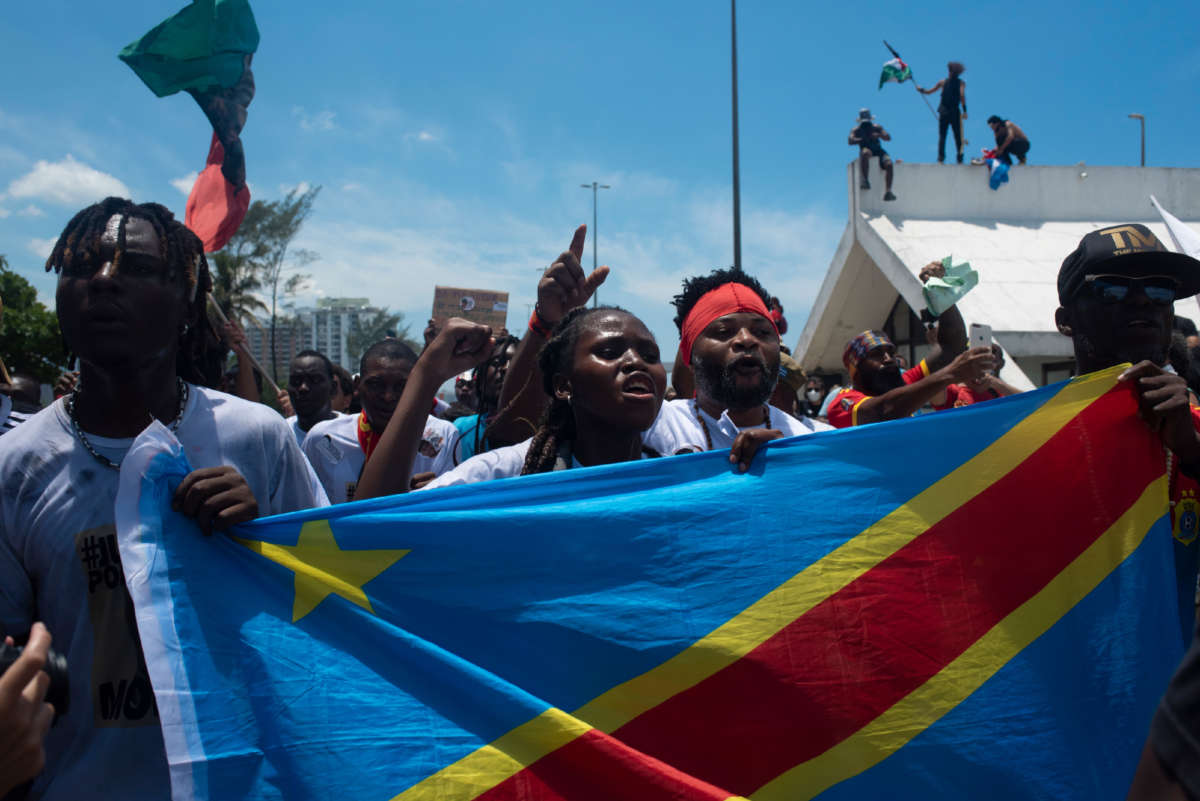
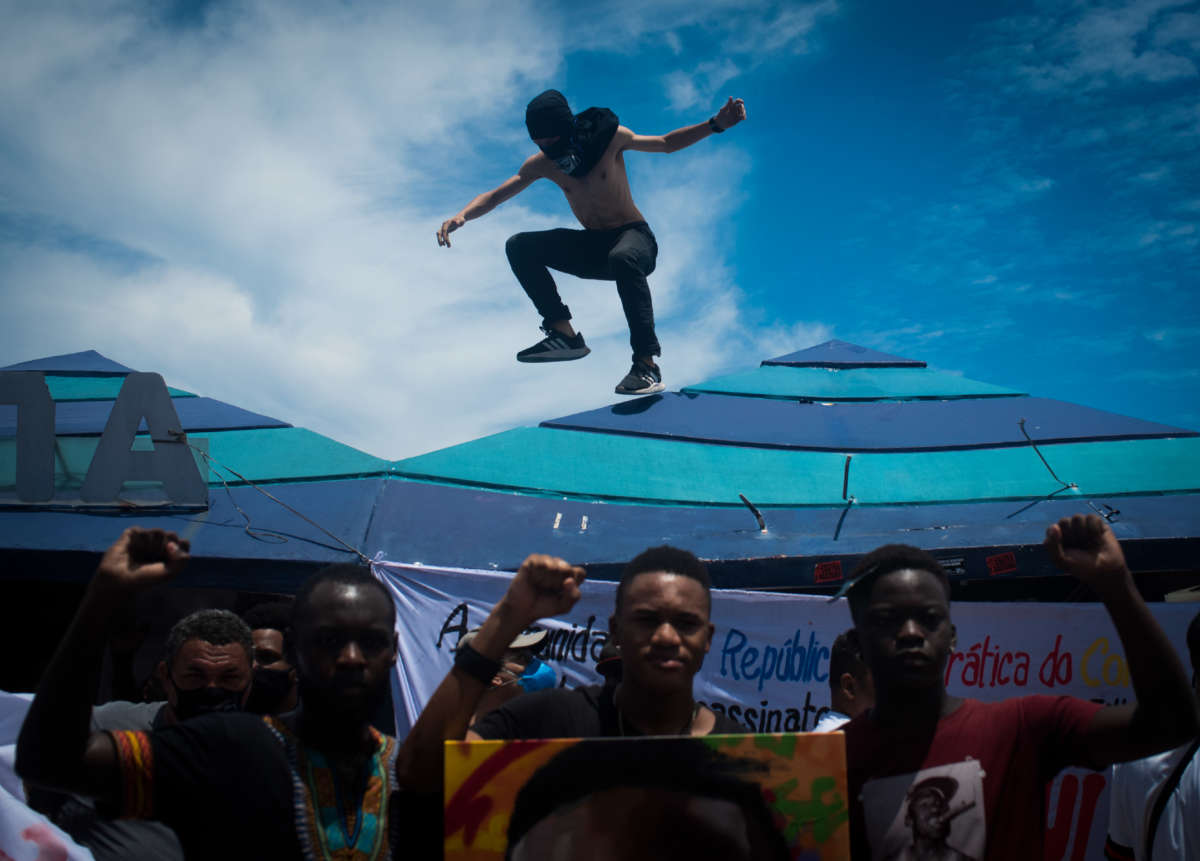
Moïse Kabagambe was a Congolese refugee fleeing ethnic conflict, who arrived in Brazil as a child in 2014 with his mother and brothers. At Barra da Tijuca, a wealthy suburb of Rio de Janeiro, Kabagambe worked for daily wages, taking drink orders from people at the beach and delivering cocktails. According to his family, on January 22, he went to the Tropicália kiosk to ask for two days of pending wages. It was then that, at the age of 24, he was beaten to death at his place of work.
At the beach where he was brutally murdered, he was known as the “Angolan.” That’s like calling a Brazilian “Venezuelan” just because these countries are on the same continent. The lack of understanding about the circumstances which brought him to Brazil in the first place is already an injustice — one which will not be reversed with someone’s imprisonment.

By 2008, the Second Congo War, which started in 1998, had killed over 5 million people and is considered the deadliest since World War II. The first one happened right before, also in the ‘90s, and was a direct result of colonial and imperialist forces meddling with African leaders and exploiting ethnic differences in the region. Zaire, which is now known as the Democratic Republic of the Congo (DRC), was made into a rope in the tug-of-war between communist and anti-communist forces, until the dissolution of the USSR and of the U.S.’s interest in endorsing its leader.
After the CIA aided a coup to replace Patrice Lumumba with Mobutu Sese Seko in the mid ‘60s, the newly instated leader enjoyed robust financial and military aid from the United States for quite a while. Toward the final years of the Soviet Union, Seko leaned diplomatically towards China, and the U.S. began portraying his administrative tactics as “grotesque.” In fact, about seven weeks after the Los Angeles Times published a piece titled “U.S. Must Cut Ties to Mobutu,” the leader was forced into exile. A year later, the DRC had entered a new, even deadlier war.
Kabagambe was born the year one war ended and as another one started, which was a period when over 5 million children did not receive an education due to political turmoil — literacy levels were at their lowest, and child labor and exploitation at their highest. Throughout his youth, his country was under a so-called “peacekeeping” United Nations operation (MONUSCO) which did more to create a clandestine weapons industry than to prevent conflict. Among the countries involved in this operation was Brazil, with its military and police personnel. Today, a Brazilian general is the force commander of MONUSCO, and he is the fourth officer from Brazil to hold the position, making it the most represented country in terms of leadership in the operation.
Much before all that, the Congo region had already lived through atrocities under a Belgian regime and its rubber industry. Between the last decade of the 1800s and the first one of the 1900s, Africans under the colonial regime of Belgian King Leopold II were enslaved, mutilated and killed at horrific rates. Famine, disease and exploitation perpetuated by colonialism and its for-profit industries were responsible for the deaths of over half of the local population — uncountable lives.
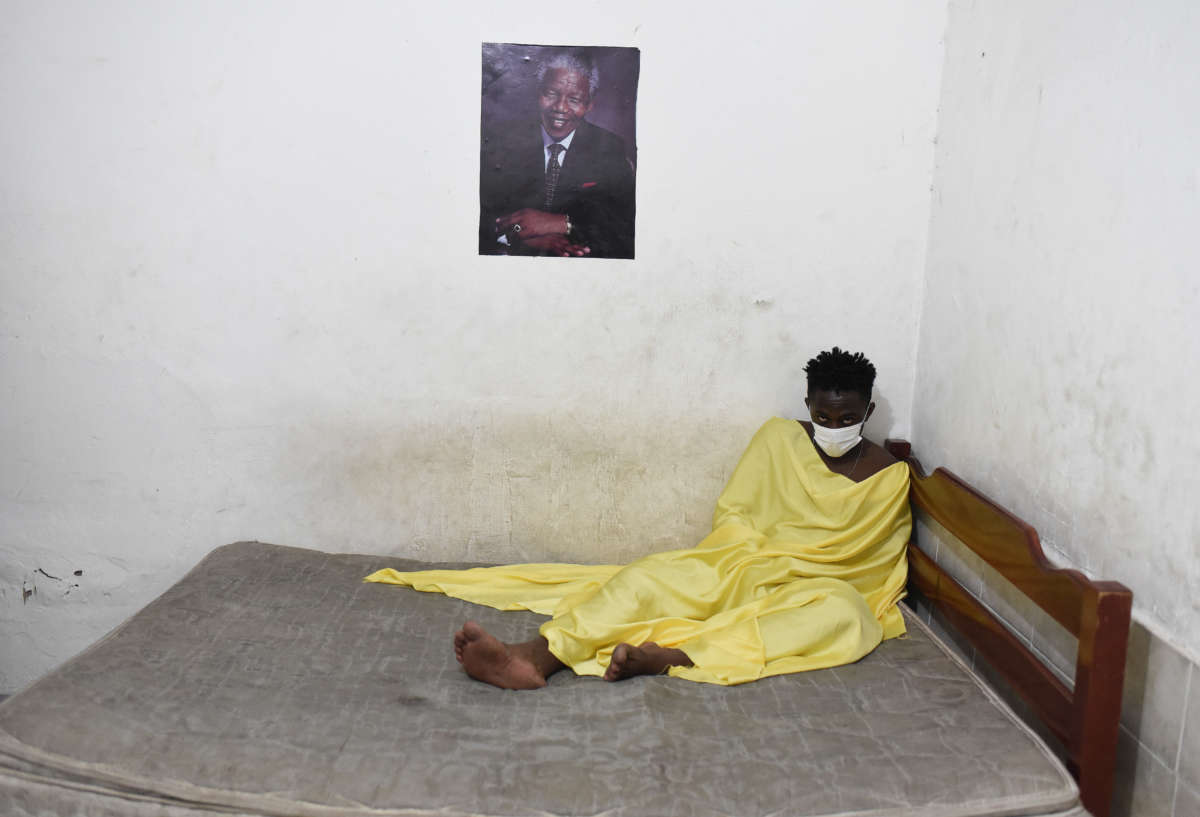
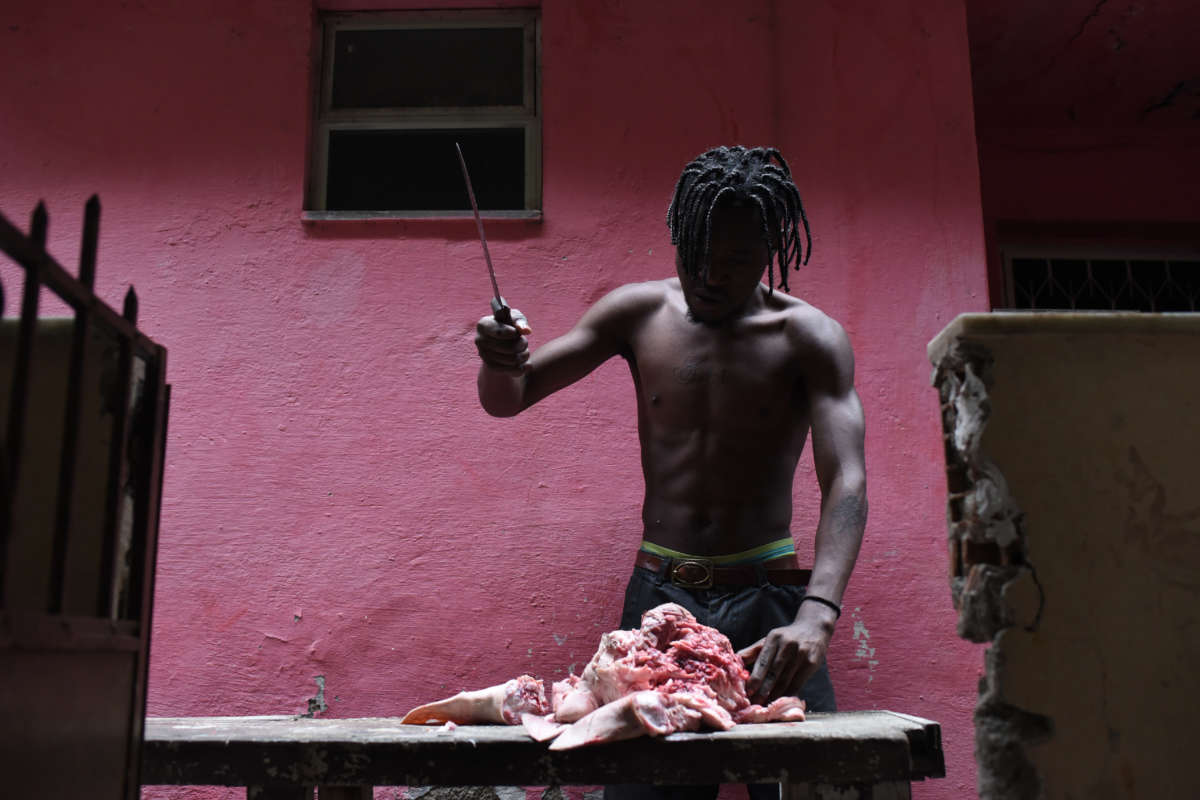
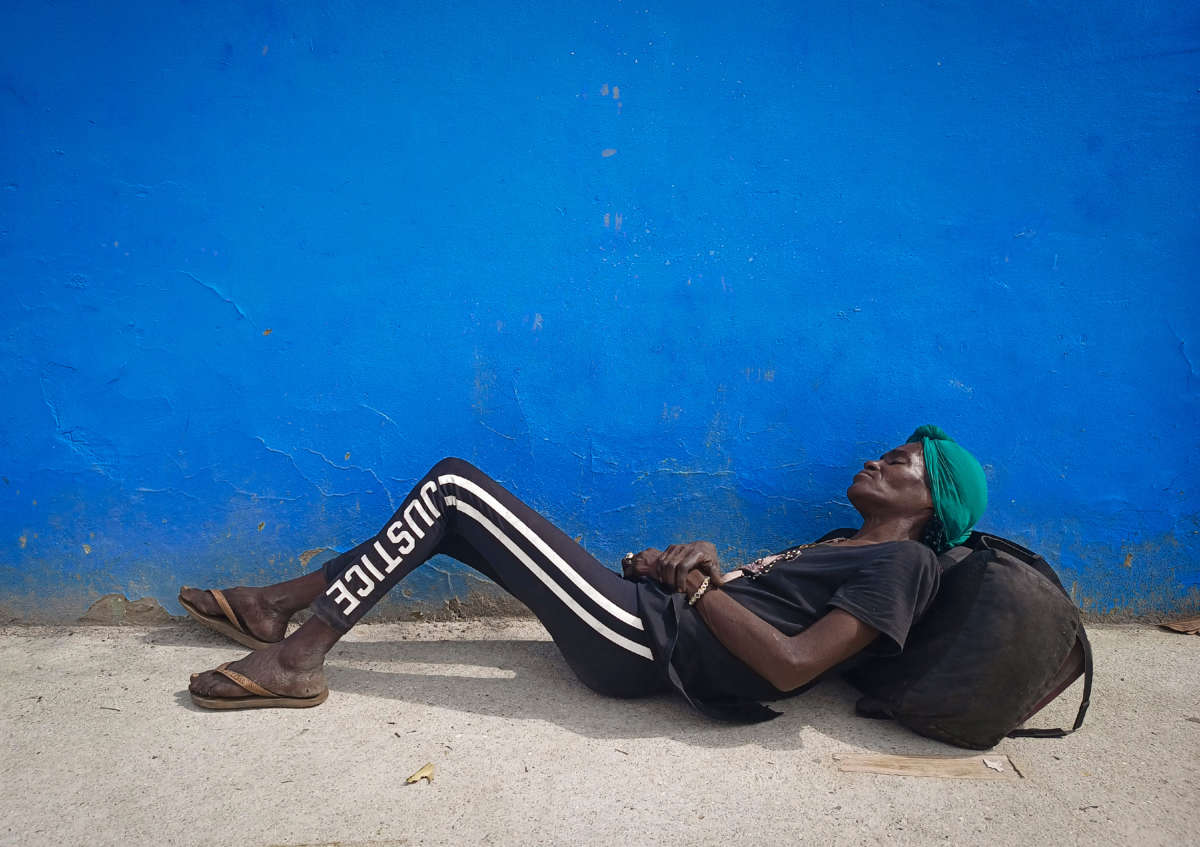
Despite incessant geopolitical opportunism, Congo has endured geographically and thrives culturally. According to the World Wildlife Fund, “The Congo Basin has been inhabited by humans for more than 50,000 years and it provides food, fresh water and shelter to more than 75 million people.” The Congo River is the largest in volume after the Amazon River. Its tropical forest is also the largest after the Amazon. As a Brazilian, our passion for preserving our most magnificent and precious asset ought to be extended to our ecological neighbor, since, together, our countries are the keepers of the world’s most important wilderness areas left on Earth.
Congolese musicians and writers have also found artistic expression as a tool for self-esteem and power. Kolinga, a Congolese group, is around today making decolonial feminist anthems. Last century, soukous and Congolese rumba hits became international classics, perhaps best represented in the Congo Revolution compilation “Revolutionary and Evolutionary Sounds From The Two Congos 1955-62.” Literature, in need of more translation and wider distribution, is even more moving and representative of the artistic tide of the nation. The poem “Second Dimension” by the Congolese writer Rais Neza Boneza, from his book, Nomad, Sounds of Exile, is particularly insightful, perhaps even specifically to the plight of Kabagambe and his immigrant community in Brazil. May it speak for itself:
Near his table rests a glass of water;
Through his window he glances at passerby:
He observes and always waits, waits, waits.Bitterness nourishes his being;
Subjected to misunderstandings
And false airs of ‘people’
He is a prisoner.He sits, hands cupped around his chin
Solemnly thinking
In his dreaming, his spirits escape
The world of hardships
And travel in the expanses of the
Wild blue skyHe leans on his table, half worried, half-contented.
In this place of his there is no compassion;
Evil prowls around its prey;
Rancor sings its melody of morning,A stranger to his land,
He melancholically sips from his glass–
A sip of freedom.
Marginalized and needy,
Very far is the wind of liberty blowing for him
He is a clandestine, always without address,
Not a nomad, but a recluse in the midst of humanity.In his unbroken crystal enclosure
He follows the echoes of his silent screams.
A rock of madness, only solitude answers him.He startles!
His heart rapidly beats!
He rises from his bed!
Ah! It’s only a nightmare!
This is a nightmare Moïse Kabagambe and his family will not wake up from, nor will the African diasporic community at large be shielded from the inhumanity of such brutal acts. But we can, as a society, begin to perceive justice as a much broader concept: Justice means seeing, respecting and appreciating the value of welcoming people into our communities. Justice means doing what we can to learn, understand and fight against a geopolitical paradigm driven by abuse and exploitation. Justice means thinking, asking and feeling the humanity in all of us.
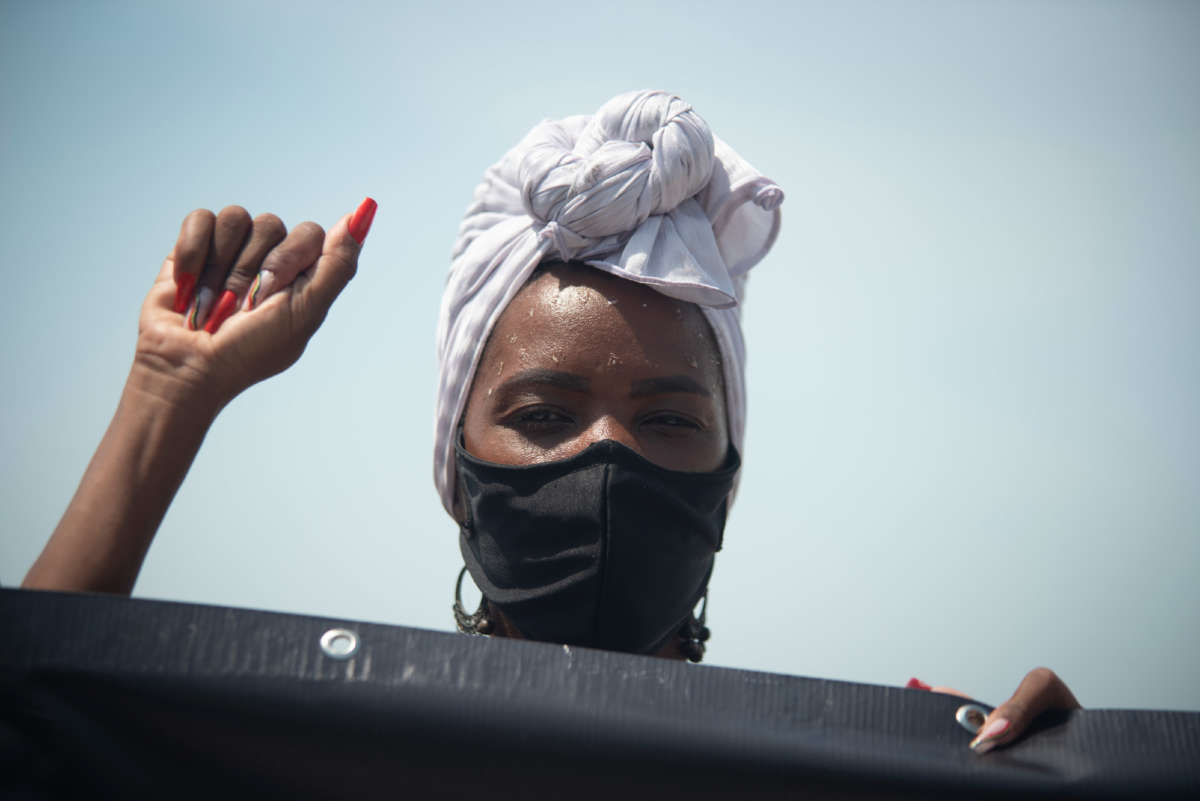
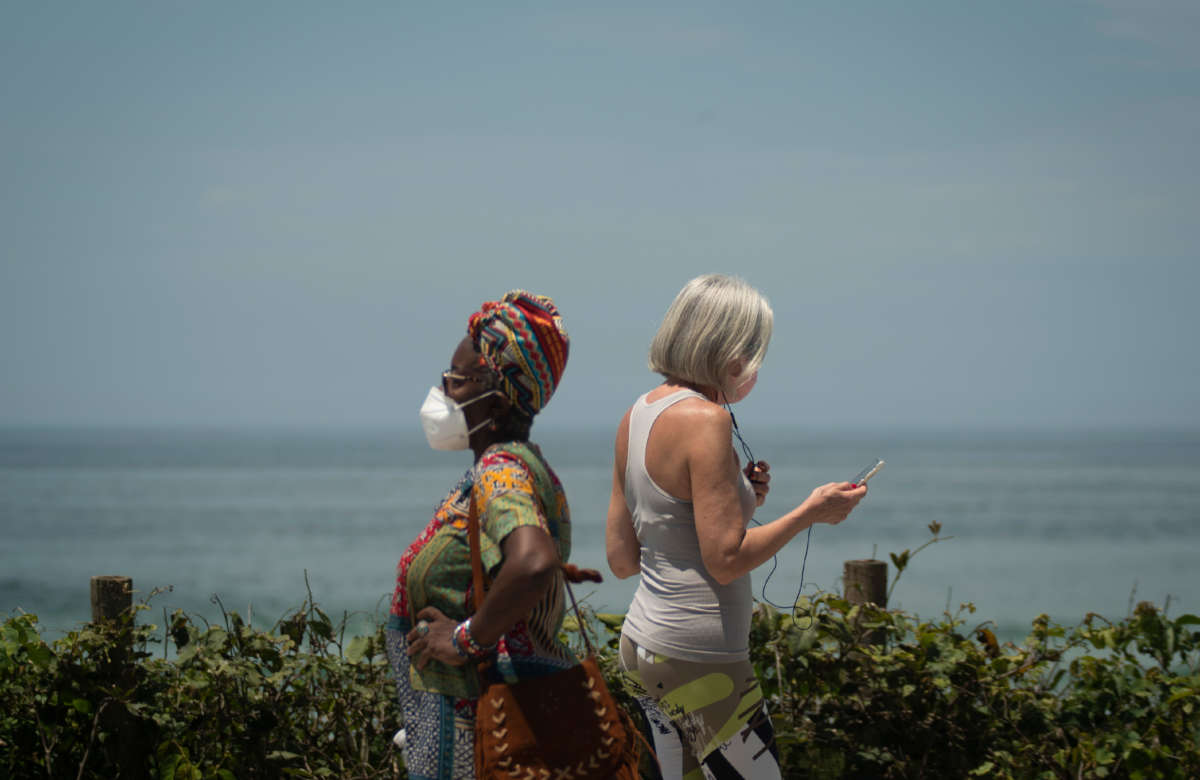
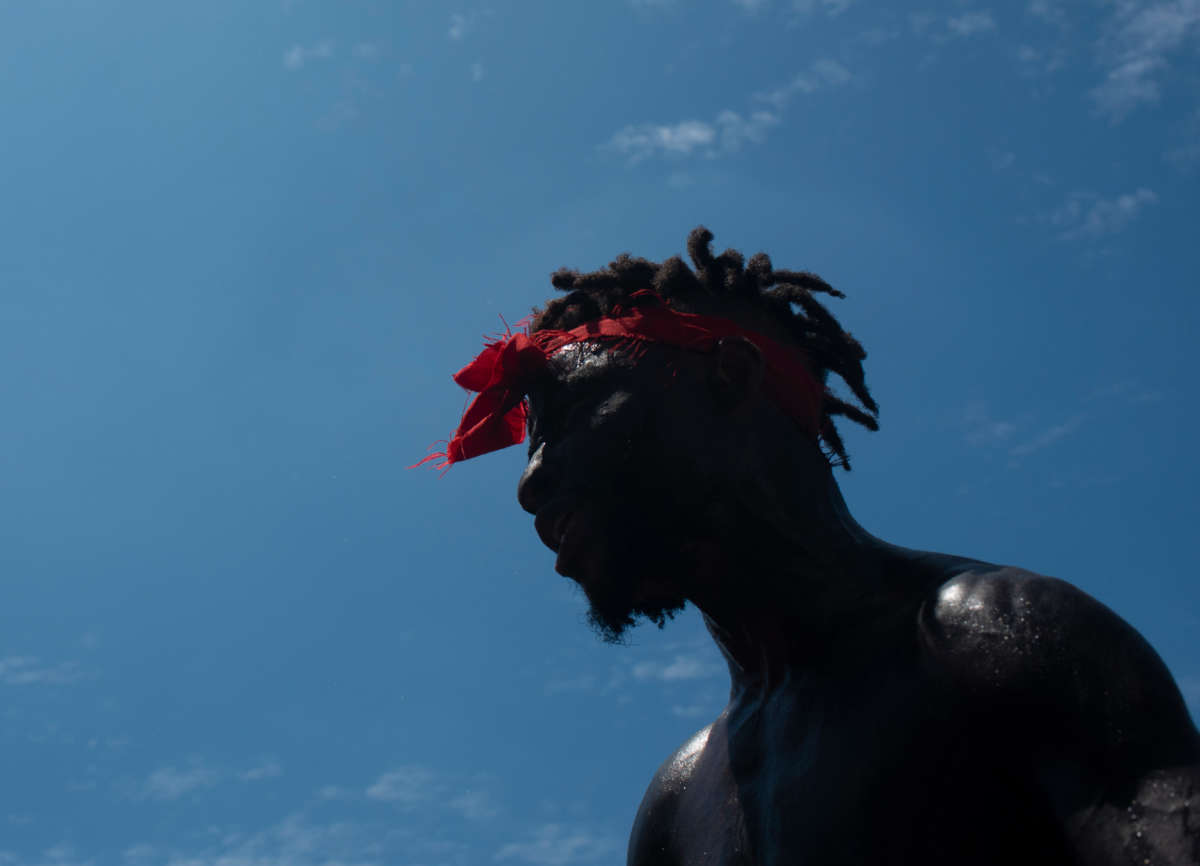
An earlier version of this article appears in Portuguese at Le Monde Diplomatique Brasil.
This post was originally published on Latest – Truthout.
Demonstrators gathered in cities across Europe, the US and South America to demand an end to Russia’s invasion
Tens of thousands of people demonstrated in cities including Santiago, Vancouver Paris and New York in support of Ukraine, demanding an end to Russia’s invasion.
The protesters rallied on Saturday against Russian president Vladimir Putin’s attack, which began on 24 February and appeared to be entering a new phase with escalating bombardment.
Continue reading…This post was originally published on Human rights | The Guardian.

Ukrainian territorial defense forces in a basement used as a military base on the 5th day since start of large-scale Russian attacks in the country, in Dnipro, Ukraine, on February 28, 2022. Andrea Carrubba / Anadolu Agency via Getty ImagesSounds of sirens and explosions have rocked Yurii Sheliazhenko’s five-story house in Kyiv every day since Russia invaded Ukraine on February 24. Sheliazhenko is the executive director of the Ukrainian Pacifist Movement and an isolated yet determined voice for peace in a country very much at war. She has experienced a “lot of hate” for refusing to bear arms and to join neighbors in making Molotov cocktails to fend off advancing Russian forces, which face stiff resistance from civilians turned fighters determined to defend Ukraine.
“Firstly, tell the truth, that there is no violent way to peace,” Sheliazhenko said when asked over email about what people in the U.S. can do to support activists in Ukraine.
Somewhere else near Kyiv, “Ilya” and his comrades have taken up arms against the Russian military and are training for battle. Ilya, who must conceal his identity due to escalating violence, is an anarchist who fled political repression in a neighboring country and decided to resist the Russian invasion. Along with fellow anarchists, democratic socialists, anti-fascists and other leftists from Ukraine and around the world, Ilya joined one of the “territorial defense” units that operate like voluntary militias under the Ukrainian military with some degree of autonomy. With support from a horizontal alliance of mutual aid groups and volunteers with civilian duties, anti-authoritarians have their own “international detachment” within the territorial defense structure and are fundraising for supplies, according to a group known as the Resistance Committee.
“When the enemy is attacking you, it is very difficult take an antiwar pacifist stance, and this is because you need to defend yourself,” Ilya said in an interview with Truthout.
Sheliazhenko and Ilya’s divergent paths illustrate the difficult and often extremely limited choices facing activists and progressive social movements in Ukraine. Notably, their different views on the role of violence in politics have led both activists to take up active struggles that seem to compliment rather than antagonize one another.
Ilya and his comrades have no illusions about the Ukrainian state, which he says “obviously has a lot of shortcomings and a lot of rotten systems.” However, Ukraine, Russia and pro-Russian separatists in Eastern Ukraine have engaged in low-level warfare since 2014, and like many others on the left, Ilya believes “Russian imperialist aggression” that could impose Putin’s style of brutal authoritarianism is the greatest common threat at this moment. Ukrainian may not be a well-functioning democracy, but anti-authoritarian activists say the country’s problems will not be solved by Russian intervention and the incredibly repressive political conditions that come with it. Demonstrators in Russia are currently defying a brutal police crackdown and risking lengthy prison sentences to protest the war.
“In Russia a broad antiwar movement is arising and I greet it for sure, but here as far as I can estimate, most progressives, socialists, leftists and libertarian movements are now taking sides against Russian aggression, which does not necessarily mean solidarizing with Ukrainian state,” Ilya said.
Sheliazhenko blames right-wing nationalists on both sides for the deadly war, which has claimed hundreds and possibly thousands of civilian lives so far. Sheliazhenko and a fellow peace activist were doxed or “blacklisted” as traitors for opposing war with Russian-backed separatists by a far right website in Ukraine before being attacked by neo-Nazis in the streets. However, she said the rise of fascist gangs and far right ultranationalists since the 2014 Maidan uprising that deposed a pro-Russian president in Ukraine is no excuse for the bloody Russian invasion as Putin has claimed.
“The current crisis has a long history of misbehavior on all sides, and further attitudes like ‘we the angels can do whatever we wish,’ and ‘they the demons should suffer for their ugliness’ will lead to further escalation, not excluding nuclear apocalypse, and truth should help all sides to calm down and negotiate peace,” Sheliazhenko said.
While many civilians have volunteered to fight with the Ukrainian military, there is plenty for activists to do besides fight the Russians as the war enters its second week. Ilya said “civil volunteers” are helping families flee violence, speaking to media outlets worldwide, supporting the families of resistance fighters, gathering donations and supplies, and providing care to those returning from the front lines. Trade unions are currently organizing resources and helping refugees as they flee war-ravaged Eastern Ukraine to the West and neighboring countries such as Poland.
Volunteers come from a variety of political backgrounds, but for anarchists like Ilya, participating in resistance provides an avenue for increasing the capacity of radicals to influence politics and social development now and after the war. Grassroots “self-organizations” that provide mutual aid and autonomous resistance are also springing up everywhere as a means of survival.
“To specify, not everyone in our unit identifies as anarchist. The more important thing is that a lot of people organized spontaneously to help each other, to guard their neighborhoods and towns and villages and to confront the occupiers with Molotov [cocktails],” Ilya said.
Meanwhile, Sheliazhenko and scattered peace activists continue to oppose forced conscription into military service with tactics that include non-violent civil disobedience. Sheliazhenko said men aged 18 to 60 are “prohibited from freedom of movement” and cannot even rent a hotel room without authorization from a military official.
Sheliazhenko said bureaucratic red tape along with discriminatory alternatives to military service prevent even religious people from conscientious objection to military service. Activists in the U.S. should call for evacuation of all civilians from conflict zones regardless of race, gender and age and donate to aid organizations that are not bringing in more arms into Ukraine that could escalate conflict, she added. U.S.-led NATO coalition has already supplied the military with plenty of weapons, and the possibility of Ukraine joining NATO was a major pretext to the war.
“Underdeveloped peace culture, militarized education training rather obedient conscripts than creative citizens and responsible voters is common problem in Ukraine, Russia and all post-Soviet countries,” Sheliazhenko said. “Without investments in development of peace culture and peace education for citizenship, we will not achieve genuine peace.”
This post was originally published on Latest – Truthout.
This content originally appeared on Radio Free Europe/Radio Liberty and was authored by Radio Free Europe/Radio Liberty.
This post was originally published on Radio Free.
By Russell Palmer, RNZ News digital political journalist
All political parties have supported a motion in Parliament to recognise the “safe restoration of Parliament’s grounds” and the selfless service of emergency services.
Yesterday, riot police moved in and dispersed the protest against covid-19 restrictions, which had occupied the Parliament grounds for 23 days.
In response, protesters set fire to tents, scrub and other structures including a children’s playground. Police in turn used pepper spray and sponge bullets as protesters lobbed cobblestones, metal poles and other debris.
The police operation resulted in 89 arrests yesterday — 40 of the 600 officers involved were injured, with eight admitted to hospital.
Parliament’s regular question time was cancelled today with party leaders instead delivering speeches on yesterday’s chaos, before adjourning early. This is standard procedure after major events, such as the Christchurch terror attacks in 2019.
‘Acts of violence cannot stand’ – Ardern
Prime Minister Jacinda Ardern began proceedings with the motion that the House recognise the safe restoration of Parliament’s grounds and the selfless service of our Police, Fire and Emergency Services, Wellington Free Ambulance, Parliament Security, and many others, in returning Parliament to the people.
The support of Māori wardens was also recognised in an amendment, at the suggestion of Te Pāti Māori.
“You were there throughout these events at a great risk to yourselves. Many of you were abused, some were injured, but you put your personal safety aside in order to look after others and for that we are very grateful,” Ardern said.
She expressed sorrow at what Wellingtonians endured, and the trampling of the mana of Taranaki Whānui. She said it was clear to her this protest was different from others as soon as it arrived.
Prime Minister Jacinda Arderns’s speech.
“There was an immediate focus on occupying the space. The rhetoric that came from the speakers they installed swung between benign to sometimes threatening. Many media who walked the grounds were either abused or in some cases chased away. It was a form of protest I did not recognise and I found it hard to reconcile it with the reality of what all New Zealanders had faced in this pandemic, and yet quietly got on with it.”
She said the demands of the protesters were hard to square with what others had suffered during the pandemic, including Labour MP Barbara Edmonds’ six-week-old niece who was recovering after a trip to hospital, having struggled to breathe after being infected with covid-19.
“And so my message today is simple, Mr Speaker, it is to condemn what happened here. Acts of violence cannot stand. It is to reinforce that this will always be a place where difference can be expressed and where that will be welcomed, but that should always be done with dignity and respect for the place upon which we stand.”
She said the pandemic felt hard right now, but it would pass; and vaccine passes, mandates and restrictions would also change.
“There is reason to feel hopeful, but for now, the smell of smoke has faded, the playground will be restored, and the people, our people, will return to their place.”
Protesters’ behaviour ‘was thuggery’ – Luxon
Opposition National Party leader Christopher Luxon also thanked emergency services and others who responded, particularly the “immense bravery and selflessness of our frontline police officers”.
He said National condemned the protesters’ behaviour, saying it was “not peaceful protest or activism, it was thuggery“.
“Those scenes were the culmination of weeks of intimidation and aggression toward Wellingtonians. We will always respect people’s right to protest, it is quite rightly a basic tenet of our democracy … but something was off in this protest from the get-go. There was real animus in the atmosphere.”
Opposition National Party leader Christopher Luxon’s speech.
He said he visited officers last night to thank them, and heard how they had all manner of things thrown at them, resulting in broken bones for some. About 80 had only recently graduated, he said, and for one he spoke to it was only her second day on the job.
“Their tenacity in withstanding the protesters provocations and remaining calm, patient and restrained is a testament to their incredible skill and professionalism and we all owe them our sincere and heartfelt thanks.”
He called for a review of the relationships between police and Parliamentary authorities, including the Speaker, as well looking for practical measures to ensure the security of Parliament while not cloistering politicians away from electors.
And while it was not appropriate for lawmakers to have a conversation with lawbreakers on the forecourt of Parliament, they could not risk writing off the concerns of other New Zealanders, he said.
“It is reasonable to expect that Aucklanders who spent 15 weeks in lockdown last year, or business owners who have lost the ability to pay their staff or put food on their family’s table will want to hold the government accountable for its decisions and promises.”
Greens: ‘There is another virus’
Green Party co-leaders Marama Davidson and James Shaw each spoke. Davidson drew particular attention to health workers who had supported the pandemic response, including social workers and community leaders who would play a role in supporting social cohesion into the future.
She said it took courage for police to maintain as much of a de-escalation approach as possible while also being urged to do something to restore a peaceful environment for Wellington.
“That approach over the history of police here in Aotearoa, has unfortunately not been applied consistently and unfortunately there has been discrimination in the way that it hasn’t and has been applied. So I acknowledge yesterday as being a really positive step in the way we police in Aotearoa.”
Seeing people come to harm yesterday had rocked her, she said, and the violence was completely unacceptable, but it had begun long before.
She urged police to investigate those who were responsible for spinning out disinformation and hold them accountable, and urged protesters to think on yesterday’s events and hold themselves accountable.
“The biggest prevention of harm would have been for the protesters to go home, that much is very clear.”
Shaw commented on disinformation and conspiracy theories by reflecting on how he was attacked in the street in 2019, “by a man who yelled at me that I had to stop what I was doing at the UN before fracturing my eye socket with his fist”.
The reasoning for that could be one of two conspiracy theories, he suggested, both with “the same root cause”.
“Twenty-nine hours later 51 people were killed and another 40 injured at the hands of a white supremacist terrorist in Christchurch. It’s apparent that the terrorist spent a great deal of his time … in the dark recesses of the internet.”
Green Party co-leader James Shaw’s speech.
He also spoke of the attack on the US Capitol last year, which he said was aimed at destabilising society and creating conditions for authoritarians like Donald Trump and Vladmir Putin. He said doubts about vaccines and mandates were “seeded by the same actors” and led to hundreds of thousands more deaths when instituted as public policy overseas.
He said New Zealand, with its “breezy, she’ll be right attitude” had almost no immunity to this other virus, misinformation, and questions like “should Parliament have a wall around it, is it ever okay to play Barry Manilow” were just addressing the symptoms.
“Yesterday the grifters and the charlatans, the political opportunists and the white supremacists who were behind the protest melted away like cowards and abandoned the field to the desperate people who they had led astray.
“I can only hope that they will be held accountable for their part in all this and that we can find a way as a country to immunise ourselves against their malign impact.”
‘Can’t talk about civil liberties when you’re threatening others’ – David Seymour
ACT leader David Seymour agreed with the motion, and used the time to criticise the protest, support the police, and to criticise the response and attitude of the government.
“There is a right to protest, but that right of protest does not extend to taking over the rights of other people around you. You can’t talk about civil liberties when you’re threatening others. You can’t talk about restrictions when you’re preventing small businesses in the area … from getting on and doing their business.”
ACT leader David Seymour’s speech.
Most protests understood that a society that observes democracy and the rule of law is worth preserving, he said, and the protest seen yesterday was different from those that had come before.
However, Ardern’s speech in response yesterday was disappointing, he said.
“So far as she’s concerned, everything is fine, the covid response is fine, it’s all because of foreign conspiracy theories driven by foreign websites. Well you know what? That sounds like a conspiracy theory in itself.
“Just to be clear, the world does have a big problem with misinformation … that doesn’t mean that everybody who has a concern is misinformed, and the problem with being unable to ‘internalise complex problems in our head’ to quote an old ad, is that we are failing to do that as politicians too.”
He also criticised the Speaker for calling the protesters ‘ferals’ and turning loud music on them.
“Where were you as the leader and custodian of this fine institution seeking a mature de-escalation. That’s what we should have seen.”
He said there were unacceptable behaviours in the protest, but also behaviours from people who felt they had been ostracised by society. A more “human response” to the pandemic from the government may not have created the seeds of “this unexpectable and despicable meltdown”, he said.
‘Colonisation … continues to divide us’ – Rawiri Waititi
Māori Party co-leader Rawiri Waititi expressed deep sadness and loss, saying the violence seen on the grounds yesterday was a manifestation of the colonial vision of those who had continuously oppressed the people through reckless laws.
“One of the key objectives of the formation of this Parliament was to kill the “beastly communism” of Māori — a quote made by a past Minister of this House: Christopher William Richmond,” he said.
Māori Party co-leader Rawiri Waititi’s kōrero.
The whakapapa of this generational trauma could only be traced back to colonisation, he said.
“Colonisation has turned our worlds upside down and has rendered parts of the culture unrecognisable. It continues to divide us today because it feasts on our trauma, thus forcing us to disregard the very essence of who we are and who we once were.”
He said when mandates did lift, we “will still be left here fighting against the racist system that is still designed to kill our ‘beastly communism’. We will still be faced with Māori health inequities, Māori education disparities, Māori being the highest incarcerated peoples in the world. Māori will still make up 50 percent of the social housing waiting list and 67 percent of the tamariki in State care.
“We will still be over half of the people in emergency and transitional housing. And the Māori unemployment rate will still double that of non-Māori. That is the true plight that we as tangata whenua have been fighting for near on 200 years, and we will continue to fight once the mandates have been lifted”.
Threats, abuse and hate towards politicians was unacceptable, he said, and it was time to heal.
“It is time for us to dig deep into our ngākau to show the world who we truly are. We are an honourable people. We are tangata whenua. We are the people of this land and it is our responsibility to ensure everyone is safe.”
This article is republished under a community partnership agreement with RNZ.
This post was originally published on Asia Pacific Report.
Police have begun a “significant investigation” into yesterday’s events at the Parliament protest and say they will hold people accountable for any criminal behaviour.
Police Assistant Commissioner Richard Chambers has held a media conference to provide the latest information on the aftermath of the anti-covid public health measures protest.
Chambers said police made 89 arrests yesterday and there had been 11 further arrests today.
He said police had now entered a “significant investigation phase”.
“We are working hard to bring together a lot of footage, support from the public and other sources of information to help us hold people accountable for their criminal behaviour yesterday.”
Chambers said the investigation would continue “as long as it needs to”. He could not say how many people police were looking for.
“If any evidence demonstrates that someone’s behaviour was criminal then we will take the appropriate action,” he said.
“One of the things that we look at is funding streams. Work on that is underway.”
A ‘proportionate’ response
More than 40 police staff were injured yesterday. Injuries range from abrasions to bone fractures and head injuries. Eight staff who were admitted to hospital had since been discharged.
Chambers said police were thankful for support from Wellington Free Ambulance yesterday.
“Having them available alongside us … was something we are very grateful for.”
Watch the police media conference:
Video: RNZ News
Chambers said he did not have a total number of injuries for protesters, but medical support was available for them.
“I can’t comment on any admissions to hospital.”
He said the force that police used was “necessary and proportionate to the situation that was in front of them”.
He said police would look at anything that suggested police force was not appropriate.
The use of fire extinguishers and bricks being thrown at police by protesters changed the police response, Chambers said.
“We did use pepper spray yesterday and that was entirely appropriate.”
‘Close eye’ on remaining protesters
Police have had officers stationed around the perimeters of the CBD area today, but have not reported any issues.
Protesters have been gathering in other areas around Wellington, including on the Miramar Peninsula.
Police were keeping a “very close eye” on them, Chambers said.
“We are monitoring all behaviour and their activity to prevent and further situations.”
Assistant Commissioner Chambers said any protesters remaining in the Wellington region should go home. He said genuine protesters were long gone by yesterday.
Police would also monitor any activity in other parts of the country, Assistant Commissioner Chambers said. He added that police would be patrolling anywhere in the country where there are protests for as long as it takes.
Controller of the investigation
As national controller of the investigation into the protest, Chambers would be kept informed of any related activity elsewhere in the country.
“What we have seen today is a number of those protests, protesters, depart and go home as well.”
Before police involved in yesterday’s operation return to their part of the country they were required to have a RAT test, Assistant Commissioner Chambers said.
Assistant Commissioner Chambers said today’s efforts in Wellington had focused on reassurance patrols and visibility.
“I’d like to say a very big thank you to the people of Wellington. The support they have shown today to police staff that were involved yesterday and today has been phenomenal.”
He said police had received “thousands” of messages of thanks for their efforts.
Auckland Domain protest camp removed
Meanwhile, in Auckland the anti-mandate camp at Auckland Domain was being disassembled today.
Police and staff from Auckland Council were onsite.
The operation was peaceful and protesters were asking police if they could move somewhere else.
An eyewitness says initially four police and a mediator approached the occupation site, and later more than 10 officers and about 40 council workers were there.
Roads in the Domain were still closed.
This article is republished under a community partnership agreement with RNZ.
This post was originally published on Asia Pacific Report.
Police are out in force in New Zealand’s capital Wellington after yesterday’s massive operation to clear the illegal anti-covid public health measures occupation of Parliament grounds.
There were chaotic scenes as protesters scrambled to save what gear they could and some were pepper-sprayed.
People set fire to trees and tents and loud bangs could be heard — possibly gas canisters exploding — as the flames spread, damaging the children’s playground and surrounding trees.
The fires were put out, allowing police to push protesters onto the streets but tensions simmered for hours.
At the height of the confrontation officers fired sponge bullets and protesters hurled bricks, pieces of of wood, rubbish and traffic cones in running battles on central city streets.
As of late last night, 87 people had been arrested for offences including trespass, wilful damage and possession of restricted weapons.
Question time cancelled
Parliament’s regular question time has been cancelled today and MPs are instead delivering speeches on yesterday’s chaos.
Prime Minister Jacinda Ardern makes an initial statement, followed by other party leaders.
The House will then adjourn early and return on Tuesday.
As damage to Parliament’s grounds and surrounding streets is assessed, the future of protest in New Zealand — both online and in person — will have to be reconsidered, said Deputy Prime Minister Grant Robertson.
This morning parliamentary services workers were out in gloves beginning the work of dismantling and disposing of piles of debris left strewn across the site when protesters were forced out by police yesterday.
The violent scenes ended a three-week occupation, and left behind couches, clothing, tents and gazebos, barbecues, gas bottles and camping gear, as well as the gaps left when paving stones were torn out and hurled at police and charred damage from fires lit in a final desperate stand.
Meanwhile, the Ministry of Health reported 23,183 new community cases of covid-19 today, with 503 people in hospital, including seven in intensive care.
In a statement, the ministry said a new death of a New Zealander with covid-19 had been recorded with a person dying in a Bay of Plenty rest home. The person died of an unrelated medical condition while receiving palliative care and had tested positive for the coronavirus.
There are 146,527 known active community cases in New Zealand.
This article is republished under a community partnership agreement with RNZ.
This post was originally published on Asia Pacific Report.
The area around New Zealand’s Parliament has today been the scene of a full-day ordeal of violence as police removed protesters whose behaviour prompted the Prime Minister to say there were “words I cannot use in this environment for what I saw”.
Early this morning, police launched an operation at Parliament and the surrounding areas in the capital Wellington “to restore order and access to the area”.
Before the sun rose, police could be seen getting information, holding shields.
As the sun set at the end of the day, about 150 protesters were peacefully facing police with riot shields on Featherston Street near the Railway Station — although other officers were clearing away signs of the earlier violence – bricks and bottles that had been thrown at them.
The afternoon saw fires lit, explosions, weapons used against police, injuries to officers and arrests at the 23-day anti-covid public health measures protest.
About 5pm, Prime Minister Jacinda Ardern addressed media and laid out just how she felt about the actions of the protesters.
Ardern said she was angry and deeply saddened to see Parliament desecrated in the way seen today, including the children’s playground being set alight.
An ‘illegal, hostile’ occupation
It demonstrated why the government refused to engage with the group, she said.
“It was an illegal occupation, they engaged in hostile, violent and aggressive behaviour throughout the occupation, and today that has culminated in the desecration of this Parliament’s grounds.
“I am absolutely committed we will restore those grounds and we will not be defined by one act by a small group of people.”
Ardern said there was a place for peaceful protest in this country, but “this is not the way that we engage and protest”. She said peaceful protest was the way to send a message, this by comparison was “a way to end up before the courts”.
Police remove protesters from Parliament. Video: RNZ News
How it played out
As the day began, some protesters had spent the night preparing for action, with cars and campervans moved to block streets.
As police moved into the area, a loud speaker blared instructions for protesters to leave or be arrested, while officers searched tents and checked no-one was in them before ripping them down.
As daylight set in, a clash between protesters and police followed.
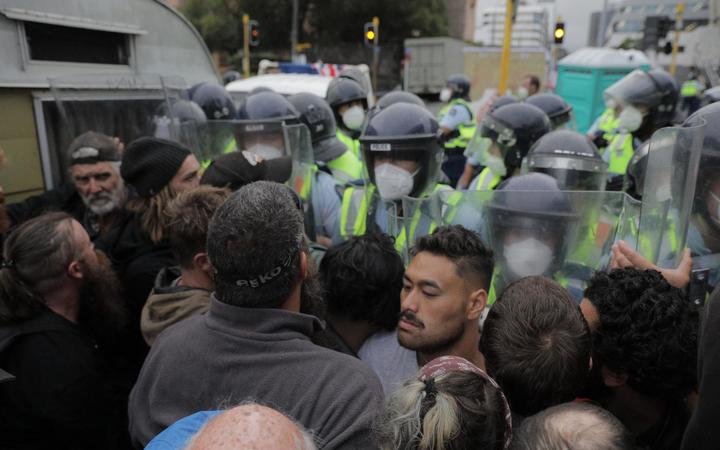
But police gained significant ground, removing a number of vehicles and structures belonging to the protesters.
Leading up to midday, police in riot gear could be seen in among the operation. Pepper spray was used in response to protesters using fire extinguishers at officers.
About noon, Police Commissioner Andrew Coster said a point had been reached “where protest leaders were either unable or unwilling to effect substantial change”.
“We have been concerned that those with good intentions have been outnumbered by those willing to use violence,” he said.
“The harm being done far outweighs any legitimate protest.”
Parliament grounds 'reclaimed': Police operation ends 23-day protest https://t.co/38TuLHV9i8
— RNZ News (@rnz_news) March 2, 2022
Balance had tipped
Until today, police had been trying to de-escalate the situation, he said. But the balance had tipped.
“We will continue this operation until this is completed.”
Commissioner Coster would not give a timeline, saying it would be when the job was done.
As the afternoon progressed, the situation heated up.
Police continued to gain ground, ripping out tents, barriers and signs, protesters physically pushed back, threw bricks, wood and other items, and used tent poles like javelins.
Gas bottles exploded and fires were lit – including Parliament’s slide and tents set ablaze.
Just before 4pm, police said they had arrested 38 people and towed 30 vehicles.
Shortly after, police gained more ground including the Beehive forecourt and then began using fire hoses to spray protesters.
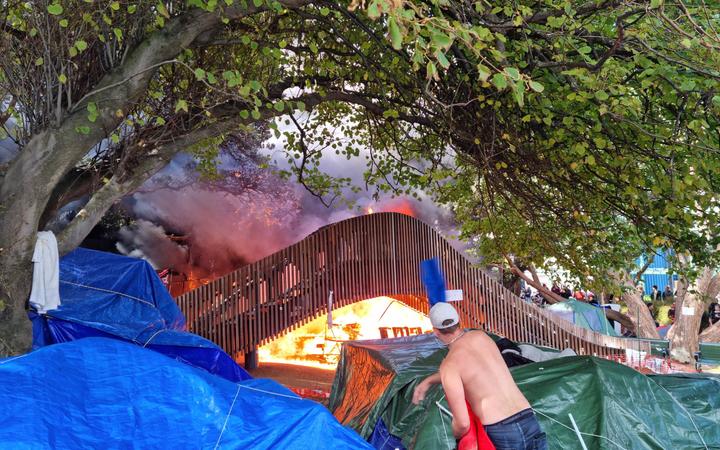
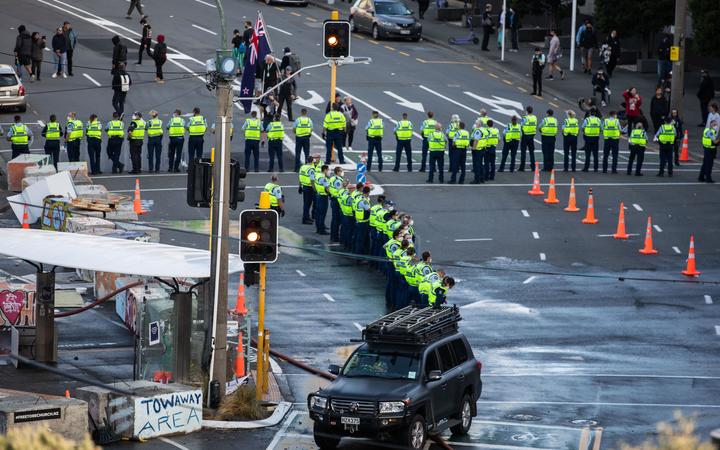
‘Grounds reclaimed’
By 6pm, police had cleared Molesworth Street of all protester vehicles. They had arrested 65 people — that number would reach 87 by late Wednesday – and towed 50 vehicles.
Not long after, Assistant Police Commissioner Richard Chambers told Checkpoint that Parliament Grounds had been reclaimed after 23 days of occupation.
“We’ve made magnificent progress today our staff have done an incredible job, in very challenging circumstances.
“You will have seen that has been met with significant resistance and violence from some, and we are very pleased with the way that our staff dealt with it today.”
Seven police staff required hospital treatment.
“They have a range of minor and serious but non-life threatening injuries. They are all receiving support and their families have been advised,” police said in a statement.
“Some injuries were lacerations caused by objects thrown at them. These included bricks and paving stones taken from the nearby streets, rocks, traffic cones, poles and wood from pallets. Staff were also showered with paint, petrol and water from a high-powered fire hose.”
Review of protest occupation
Ardern signalled there would be a review of the protest occupation at Parliament to determine if more could have been done to prevent it from happening.
Coming into the evening, police said they would continue efforts to clear Parliament grounds overnight.
There will be a substantial police presence in Wellington and at Parliament, and residents should be assured that police will continue to make their presence felt and keep them safe.
A small number of protesters remained near the Victoria University Pipitea campus.
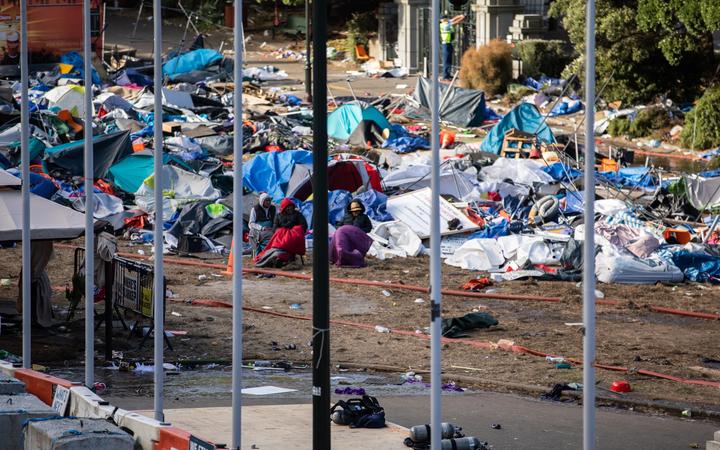
Late on Wednesday evening, Speaker of Parliament Trevor Mallard said in a statement that Parliament’s grounds would be closed until further notice.
‘Recovery plan’
“A recovery plan for the grounds has been developed which includes working with mana whenua and coordinating offers of assistance from volunteer groups,” he said.
“Due to assessments of the grounds’ condition that must take place before that work can begin, and for health, safety, and sanitary reasons, I ask that all members of the public please stay away till advised otherwise.
“I’d like to take this opportunity to thank the police, Parliamentary Security, Buildings and Facilities, Health and Safety teams and all other staff for their continued efforts to keep everyone at Parliament and the surrounding areas safe.
“Their resilience and understanding, along with all of you who have been affected by this protest must be acknowledged and thanks given for everyone’s hard work and messages of support.”
More information about the recovery plan for Parliament’s grounds would be released when it was available, Mallard said.
“We will restore our beautiful grounds and I will keep you informed of developments.”
This article is republished under a community partnership agreement with RNZ.
This post was originally published on Asia Pacific Report.
Prime Minister Jacinda Ardern says she is saddened and angered by protesters’ actions today, and that the New Zealand Parliament’s grounds have been “desecrated”.
Ardern addressed media after an afternoon that saw fires lit, explosions and objects thrown at police as an anti-covid public health protest sparked violent scenes.
There have been multiple arrests, vehicles have been towed away and some police and protesters have suffered injuries.
Some set fire to protesters’ tents arousing concern that gas canisters would explode, and some large blasts were heard.
Police were able to take back most of the ground the protesters had been occupying for the past three weeks.
Ardern said she was angry and deeply saddened to see Parliament desecrated in the way seen today, including the children’s playground being set alight.
She said it demonstrated why the government refused to engage with the group.
‘An illegal occupation’
“It was an illegal occupation, they engaged in hostile, violent and aggressive behaviour throughout the occupation, and today that has culminated in the desecration of this Parliament’s grounds,” she said.
“I am absolutely committed we will restore those grounds and we will not be defined by one act by a small group of people.”
Asked about those who had been throwing projectiles at police, including LPG bottles thrown on flames and cobblestones hurled at officers, she said there were “words I cannot use in this environment for what I saw today”.
She said while the events today did not surprise her — considering the anger protesters had already expressed in the past few days — Ardern said it did sadden her.
PM Jacinda Ardern’s media briefing outside Parliament
Video: RNZ News
She said anyone still throwing projectiles should “put down their weapons long enough for police to arrest them”.
Ardern said there was a place for peaceful protest in this country, but “this is not the way that we engage and protest”.
She said peaceful protest was the way to send a message, this by comparison is “a way to end up before the courts”.
Asked if protesters would be able to return overnight or tomorrow, Ardern said police would be present at Parliament.
She said the police commissioner wished to make the point that there would be a substantial police presence in Wellington, and locals should be assured that while this had been a distressing period, police would continue to make their presence felt and keep them safe.
Ardern said she knew that in planning for today’s operation, police had expected there would be “hostility, resistance and violence”.
“They planned for that because that is what they and Wellingtonians have experienced for several weeks now.”
She said while they planned for it, it was another thing entirely to witness it.
Thanks to frontline police, emergency services
“To our frontline police and emergency and fire services, you have our deep admiration and our thanks. You have been calm but resolute in trying to bring this occupation to a conclusion,” she said.
“It has come at great risk to your personal safety. Thank you for putting others before yourselves.”
She said she had spoken to the police commissioner and there have been various injuries sustained by officers, but she would leave it to him to go into more detail.
Ardern said the fires created in the front of Parliament, including at the war memorial were causing more distress than what the police would have done today.
She said she believed the force that was used was used to keep others safe.
She said police have been mindful of the presence of children throughout the occupation, and there were other agencies present should there be a situation where children were left unsupervised or uncared for, such as if parents were arrested.
Infected 20,000 in one day
Ardern said it was almost impossible to comprehend that people would stand opposed to efforts to slow down the spread of a disease, when it has infected 20,000 and put more than 400 in hospital in just one day.
She said while many had seen disinformation and dismissed it as conspiracy theory, a small portion had believed it and acted on it in a violent way.
“This cannot stand.”
Ardern said this afternoon’s events were an attack on frontline police, an attack on Parliament, and an attack on New Zealanders’ values, and it was wrong.
“Our country will not be defined by the dismantling of an occupation. In fact when we look back on this period in our history, I hope we remember one thing,” she said.
“Thousands more lives were saved in the past two years by your actions as New Zealanders than were on that front lawn of Parliament today.
“The sacrifices we were all willing to make to look after one another, that is what will define us, no protest, no fire, no placards will ever change that. Today the police will restore order and tomorrow your government will work hard to get us safely back to the normality everyone deserves.”
About 270 protesters
Ardern said there was nothing to suggest that security settings as a country needed to change in response to the protest. She said it was estimated there were about 270 protesters who were causing the acts of violence and destruction seen today.
“That demonstrates it only takes a relatively small group of people who are committed to destruction to cause it, should they so choose. But it also demonstrates it was not a large group who were engaging in those acts either.
“We are not going to dismiss some of the underlying causes of what we have seen, but nor will we excuse it.”
She said work would be done to address how misinformation and disinformation led to what was seen today, but the government “will be at pains to ensure that it never becomes an excuse for the violent acts that it resulted in”.
“It’s a dangerous place when citizens are led into spaces where they believe so deeply in conspiracy theory that they react with such violence.”
Ardern acknowledged there have been for a long time a group of New Zealanders who have been living on the margins and have subscribed to other conspiracy theories, and “this happens to be the current rallying cry”.
Ardern said finding a solution to disinformation and misinformation was not about taking away people’s ability to have differing opinions or debate, to take different positions.
“People should of course always have that freedom of thought and view and perspective and in New Zealand we’ve celebrated that, but when the debate you’re having is no longer based on fact, where does that take you? That is the challenge we have.”
This article is republished under a community partnership agreement with RNZ.